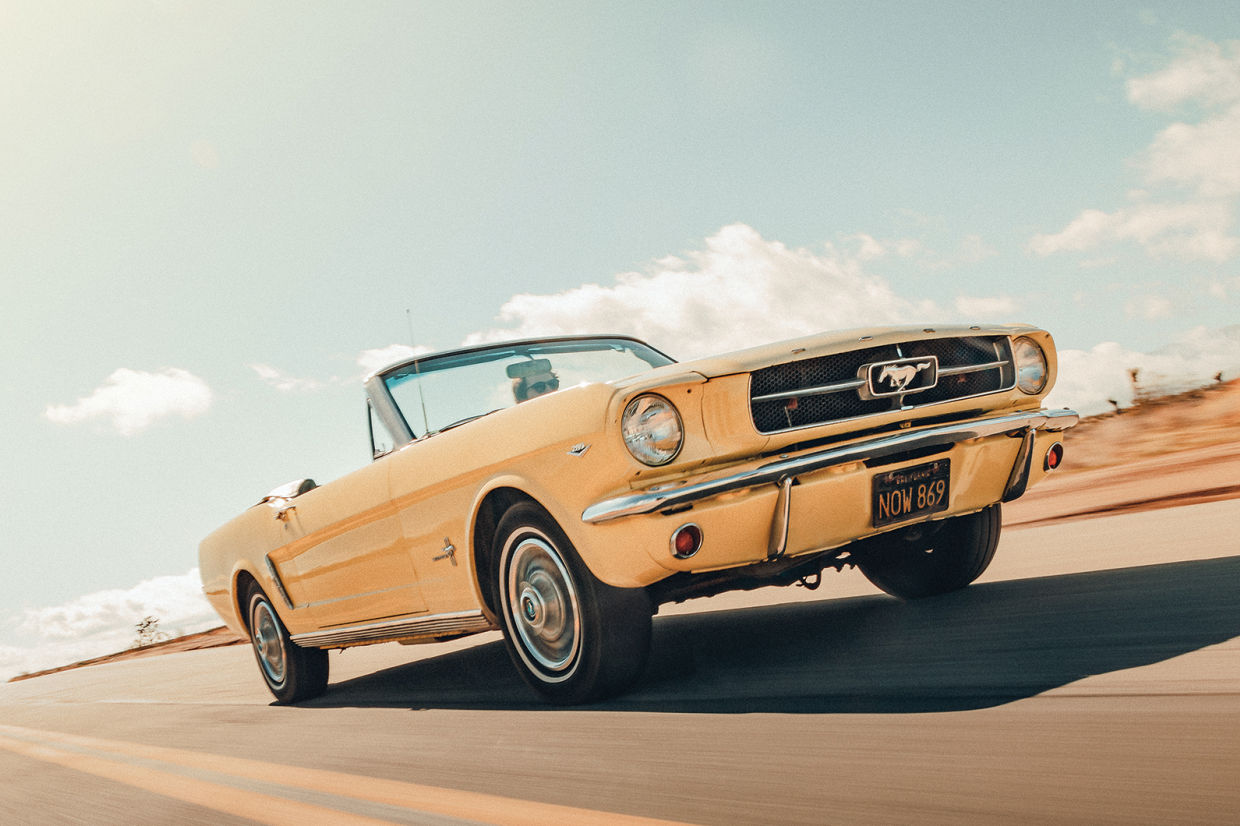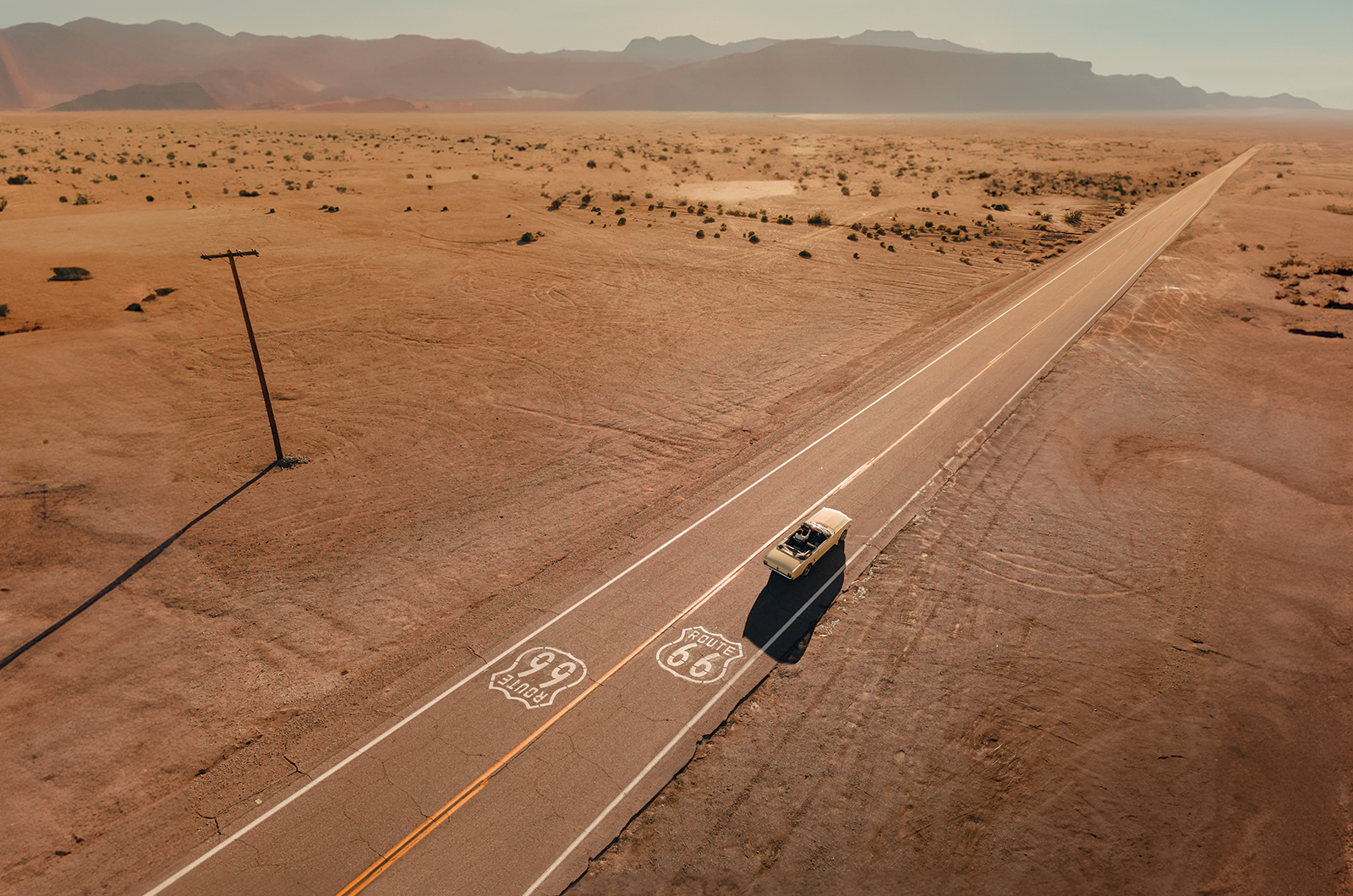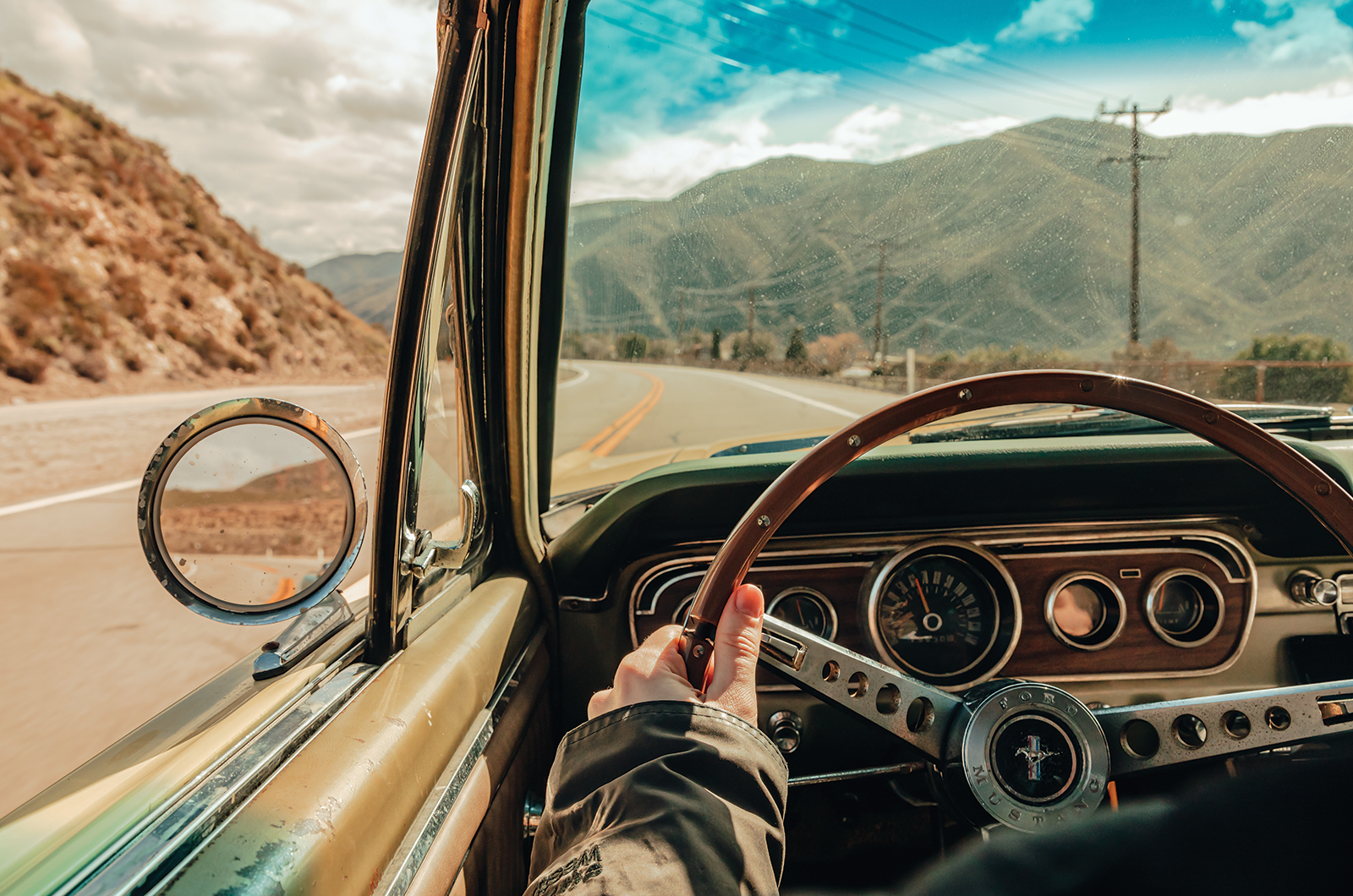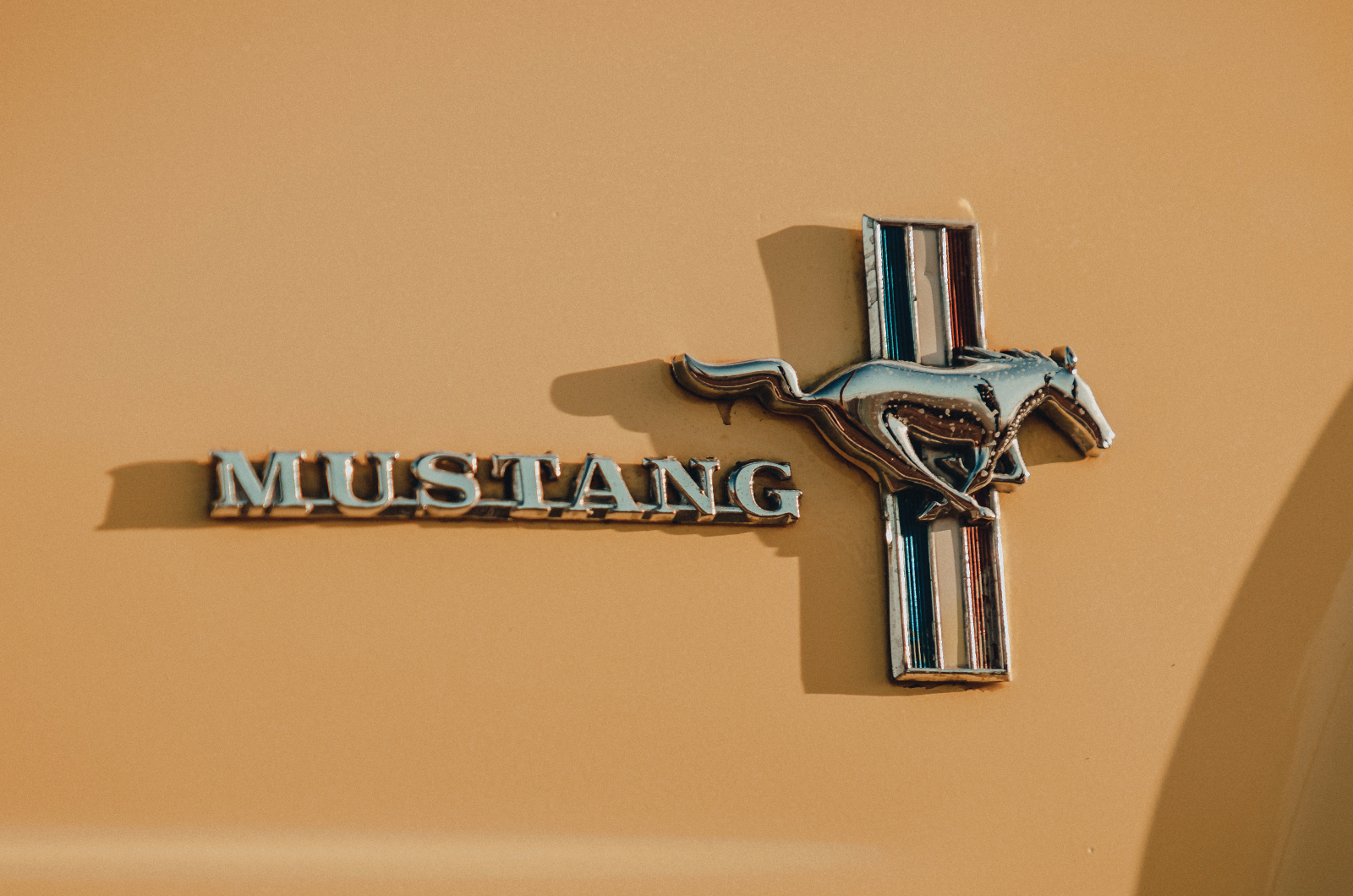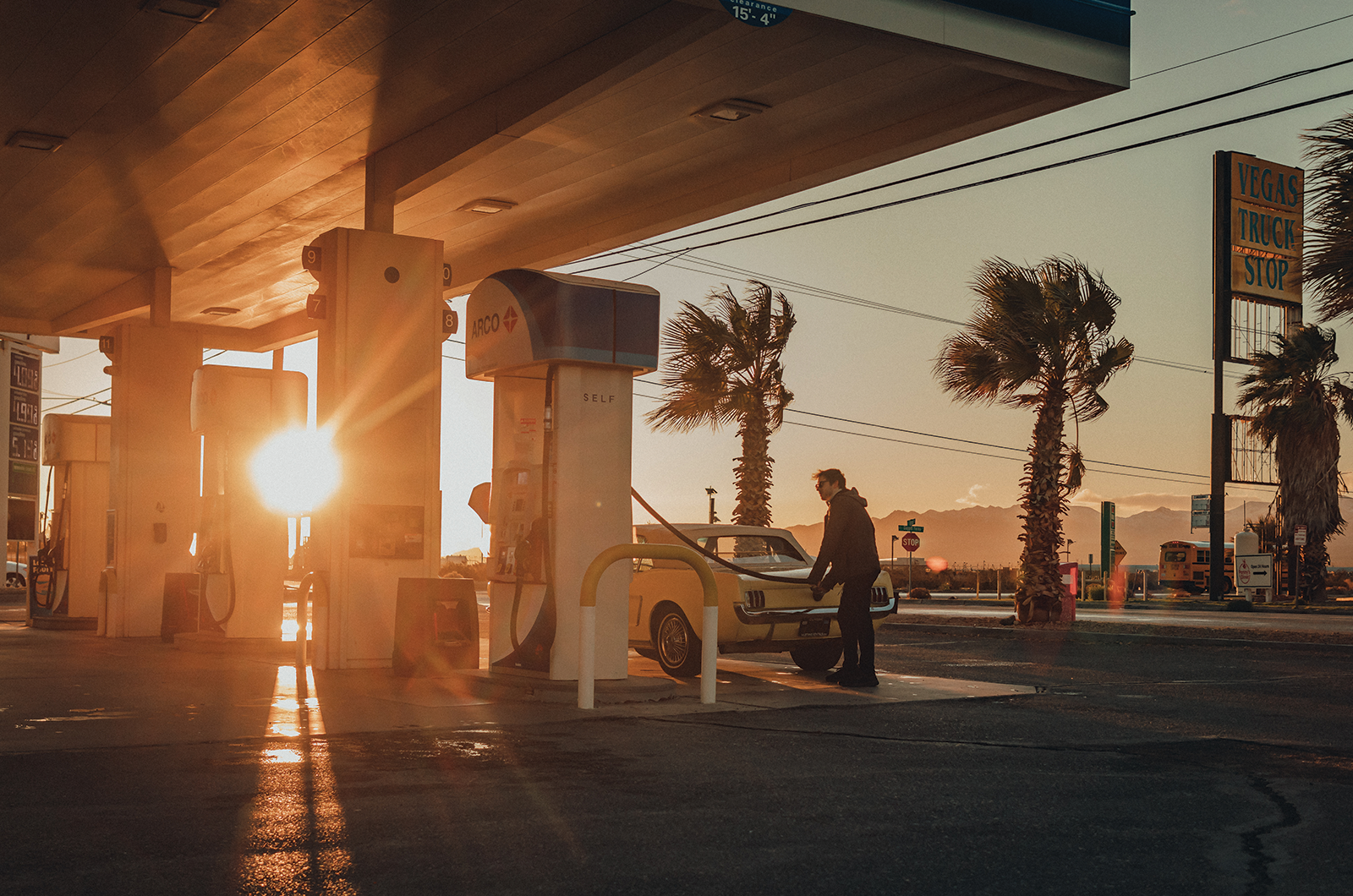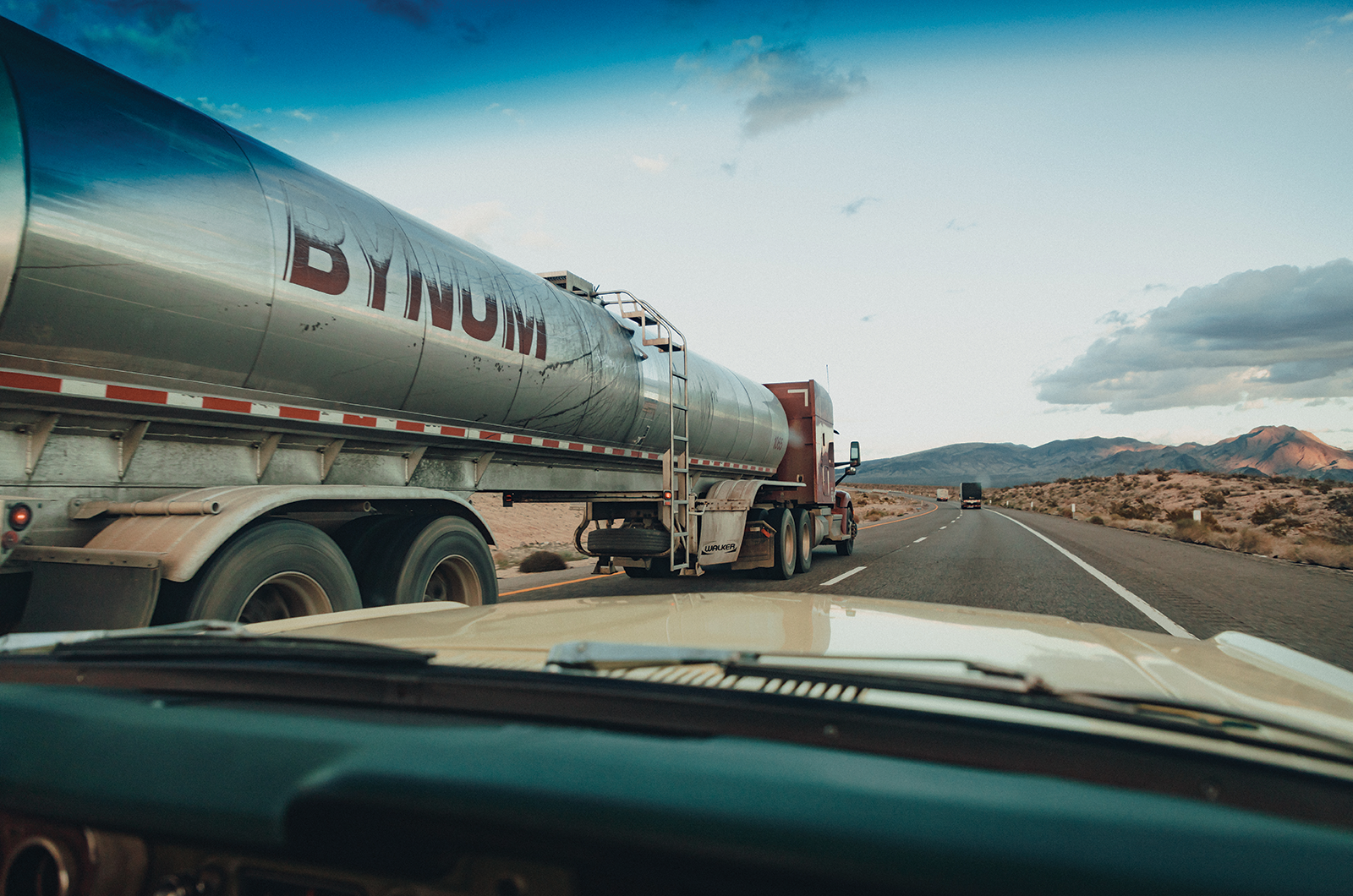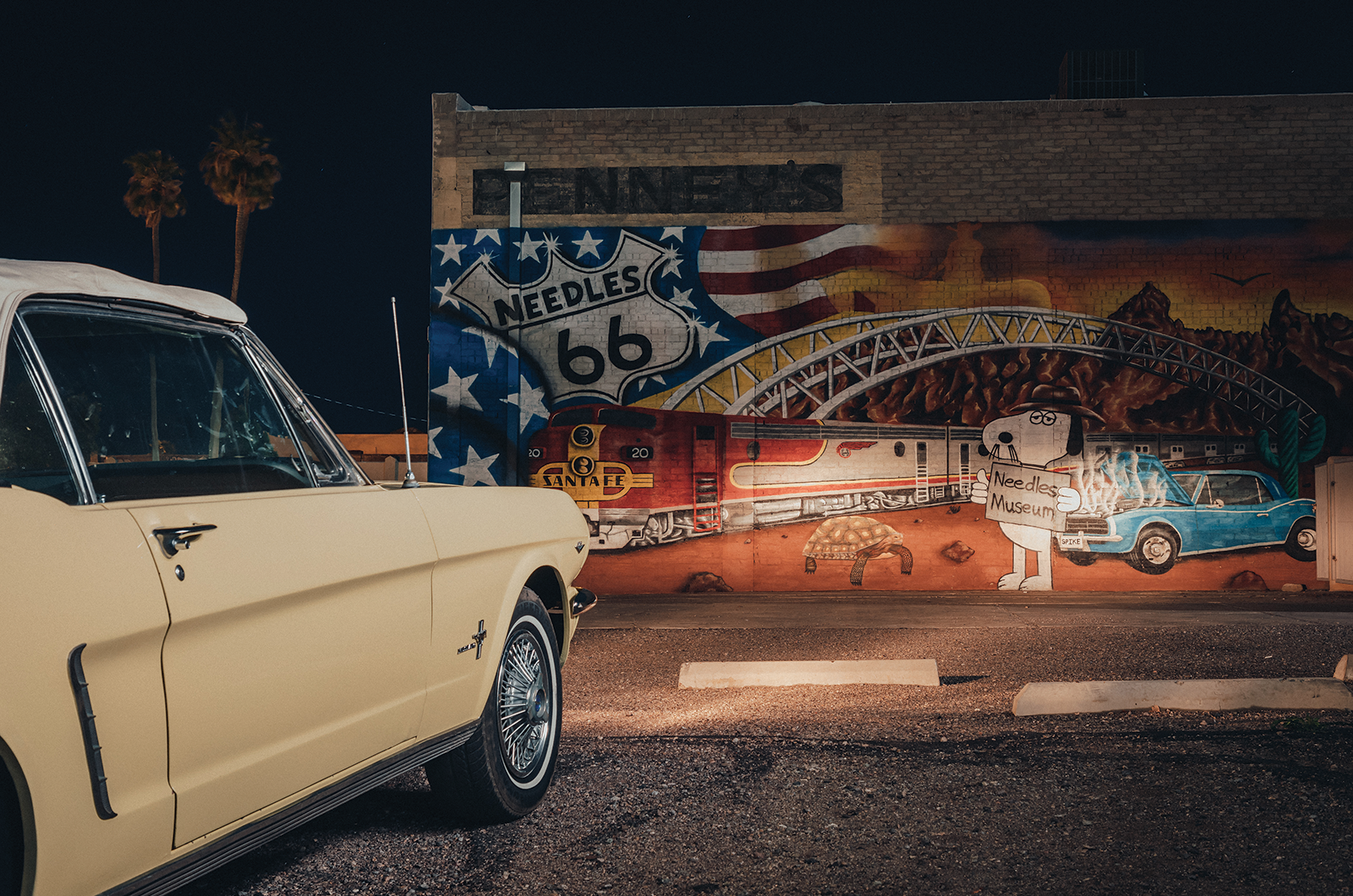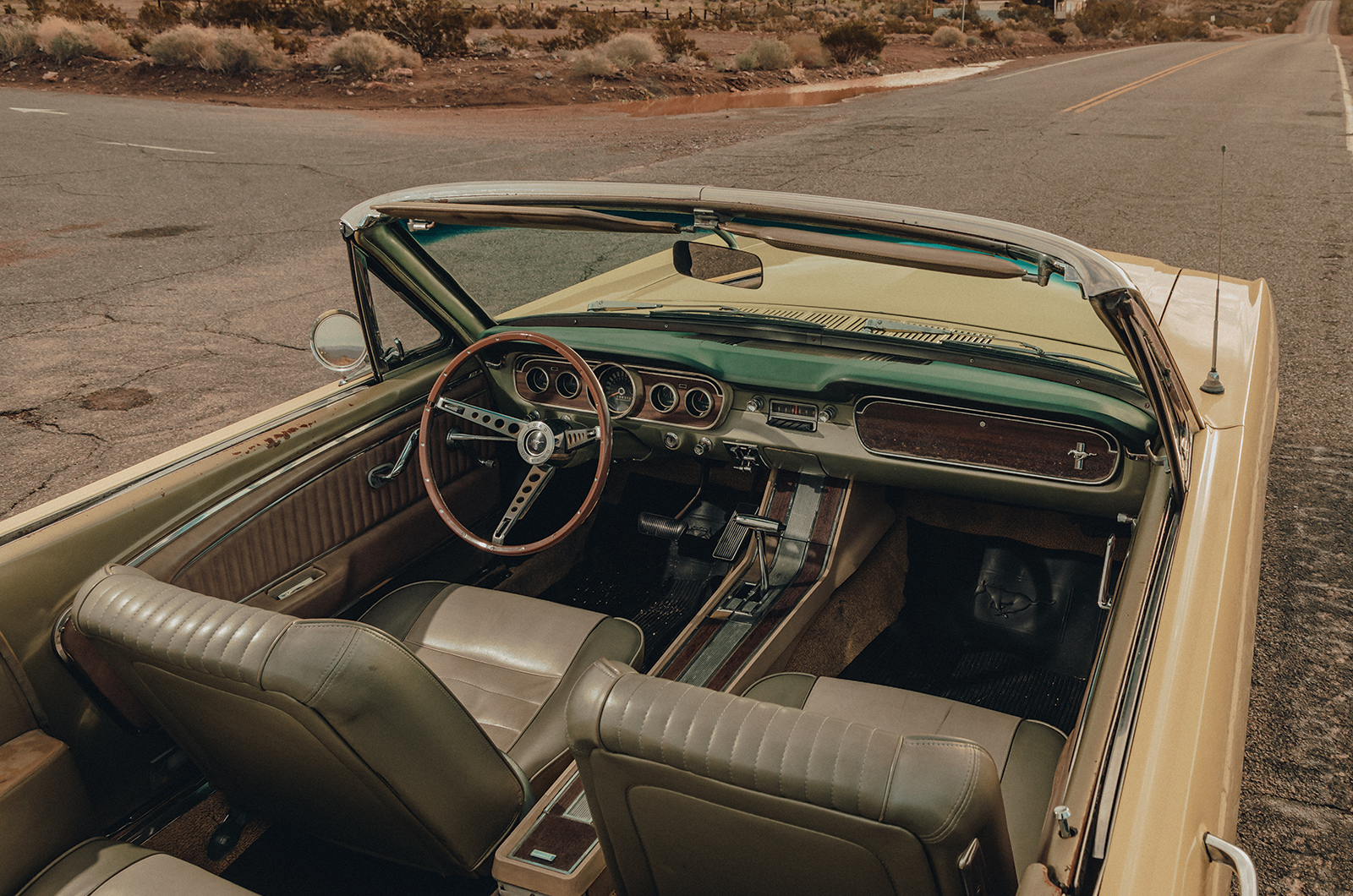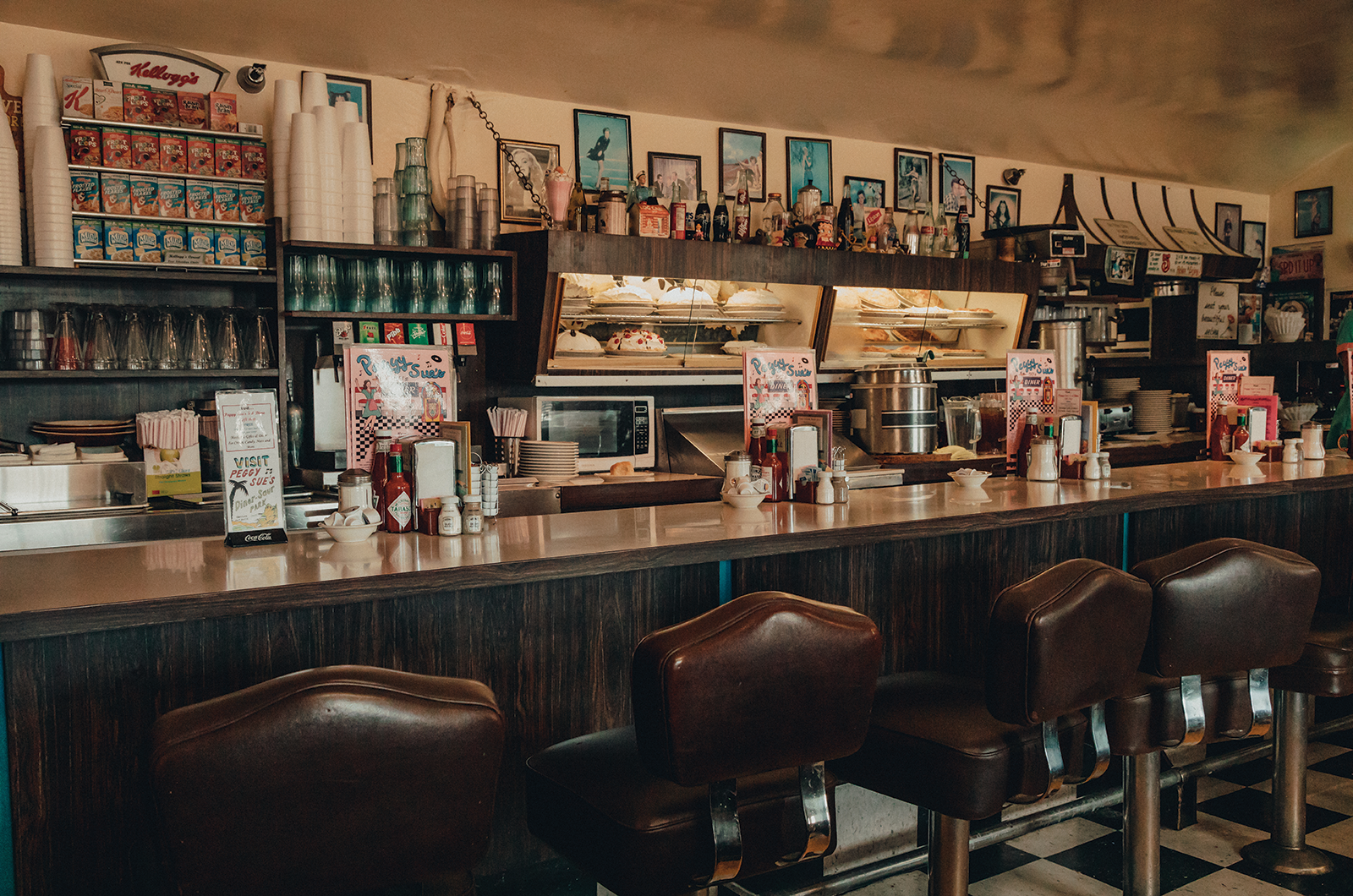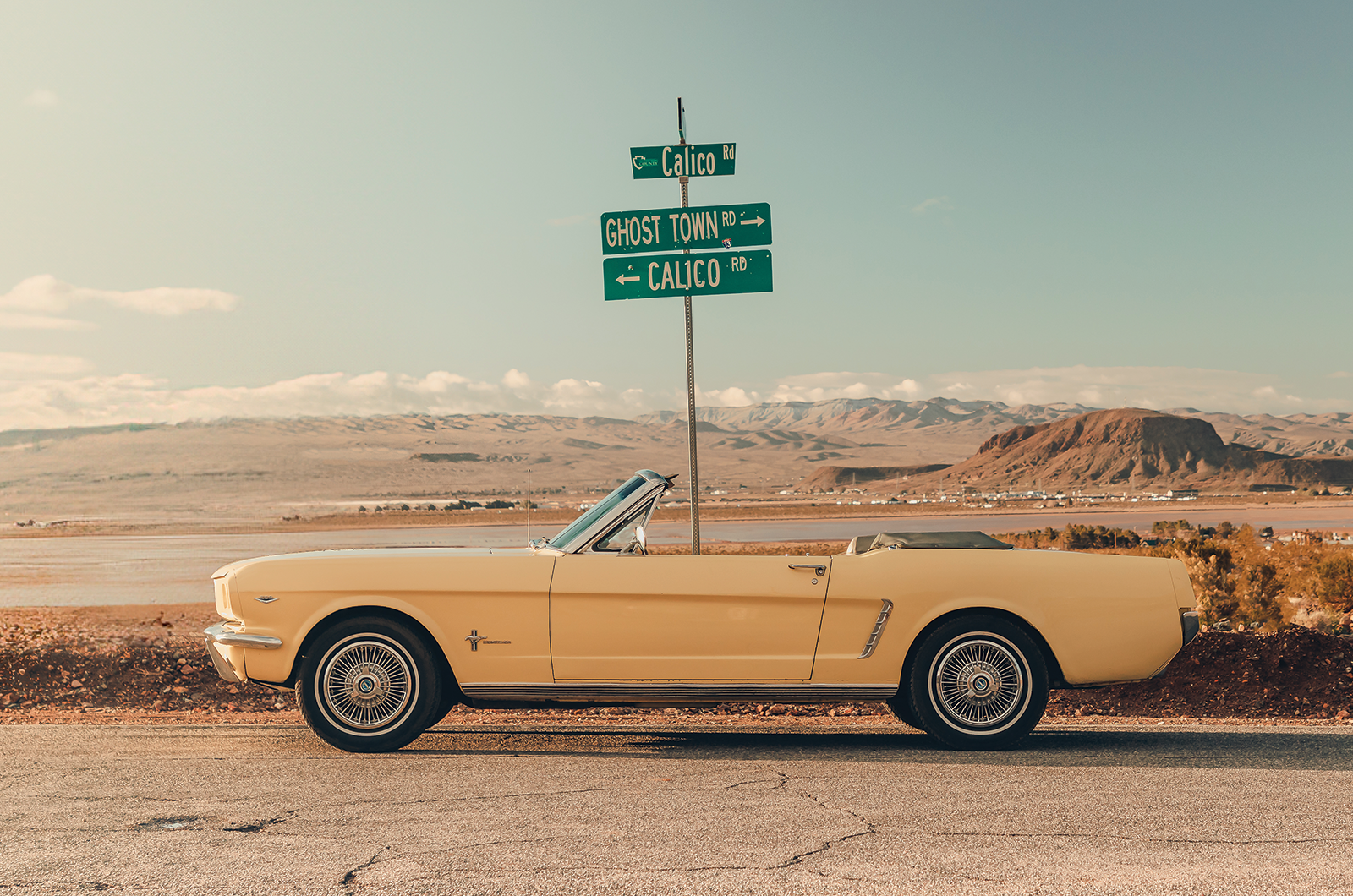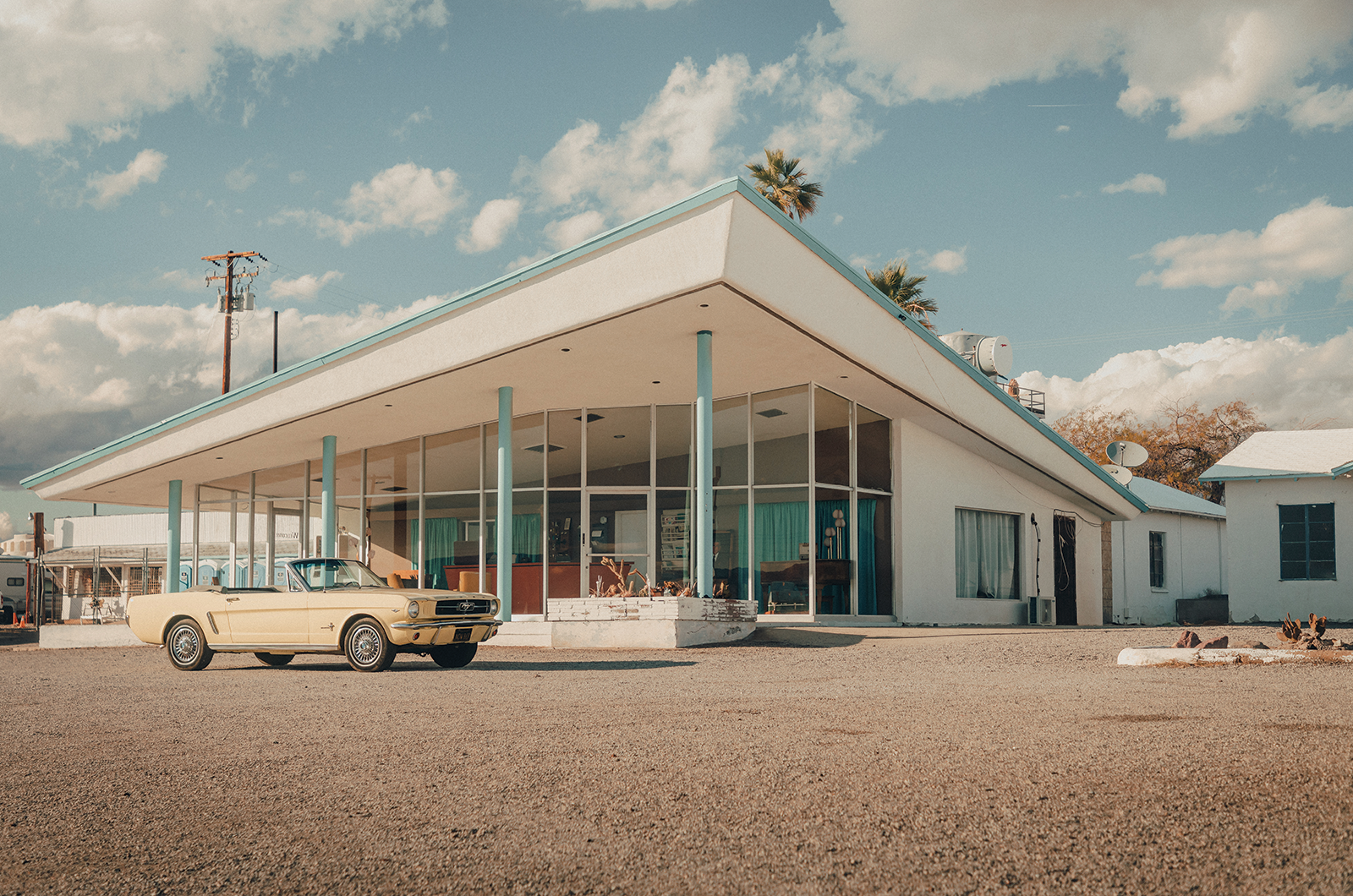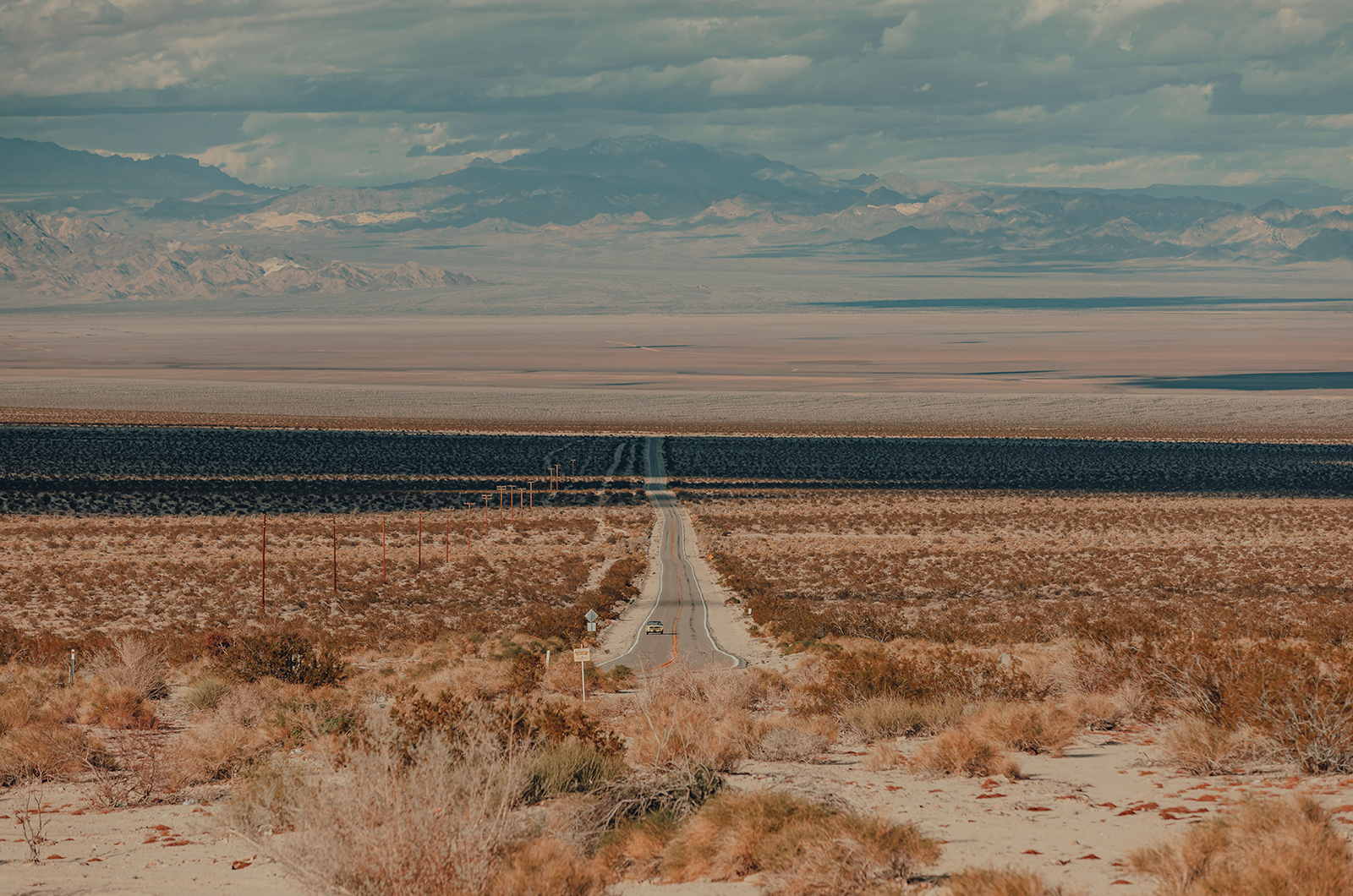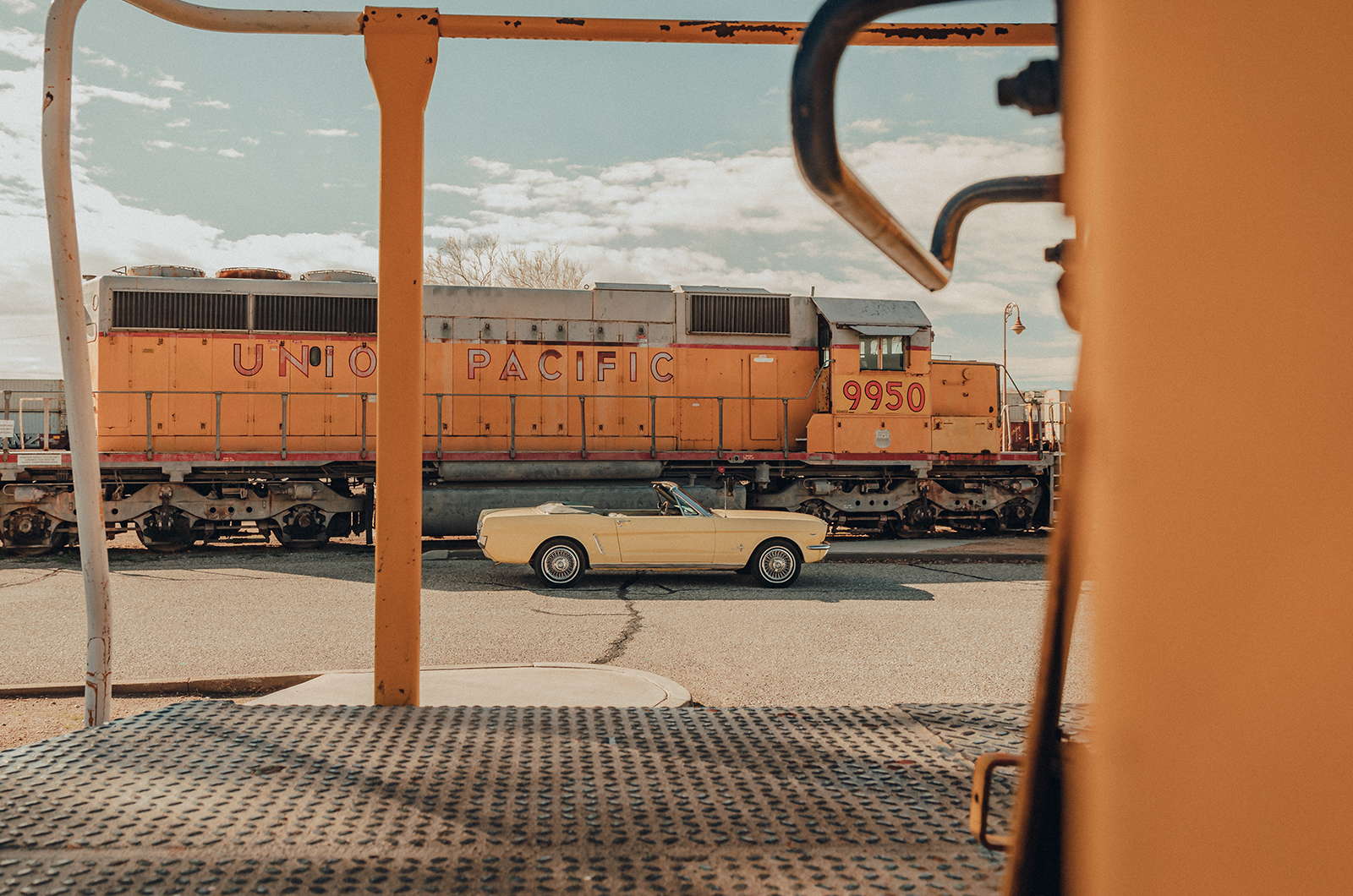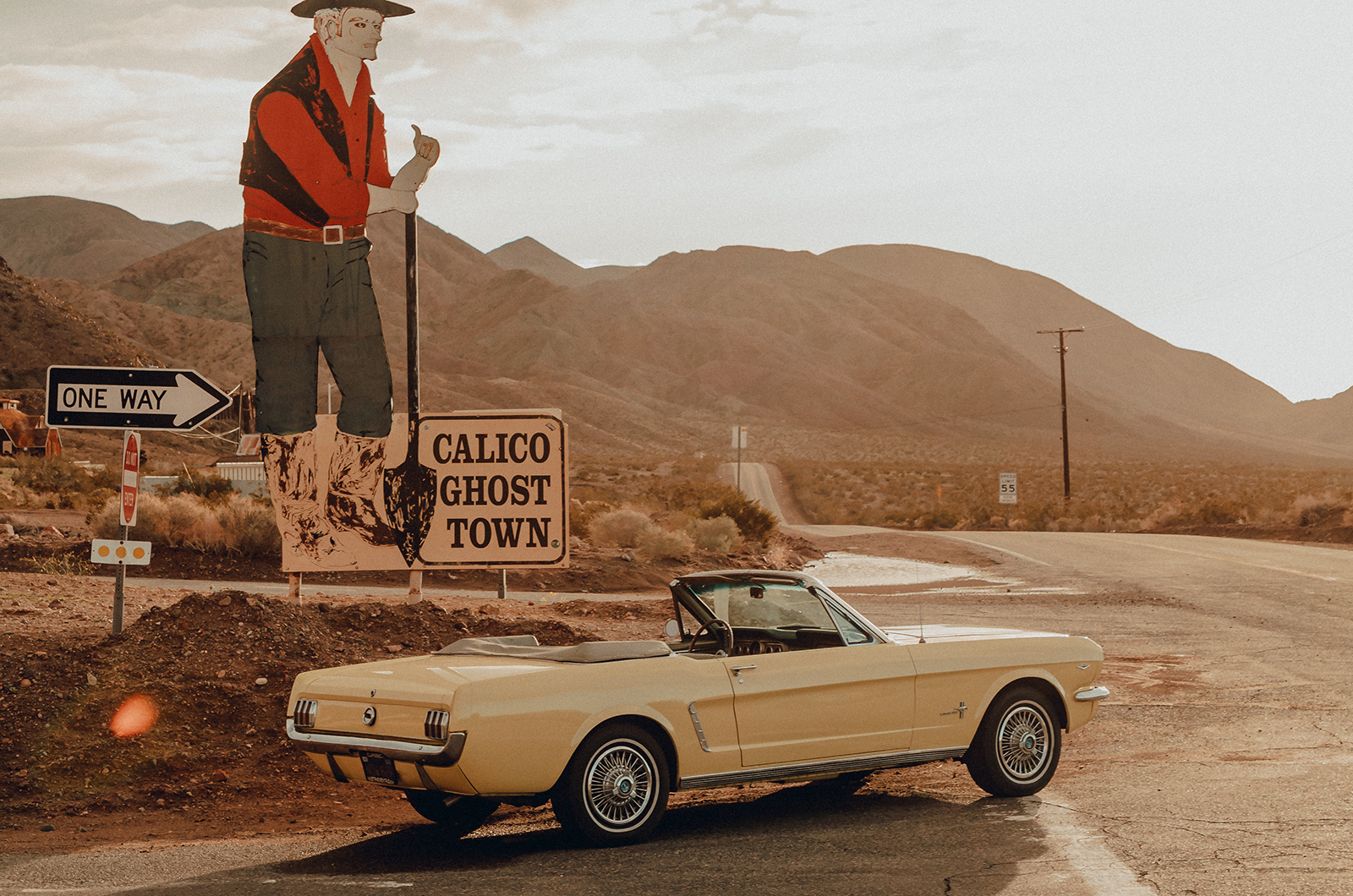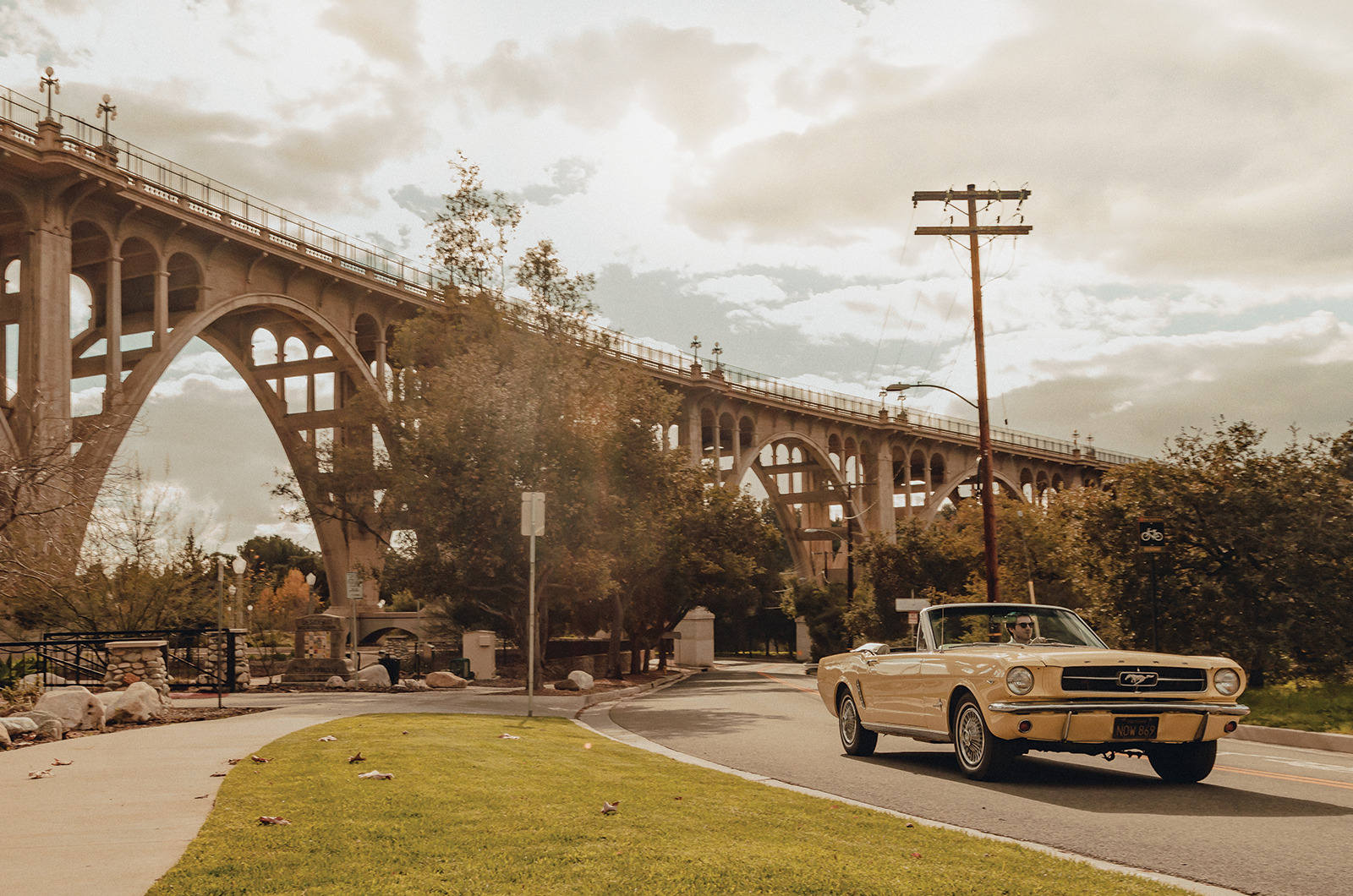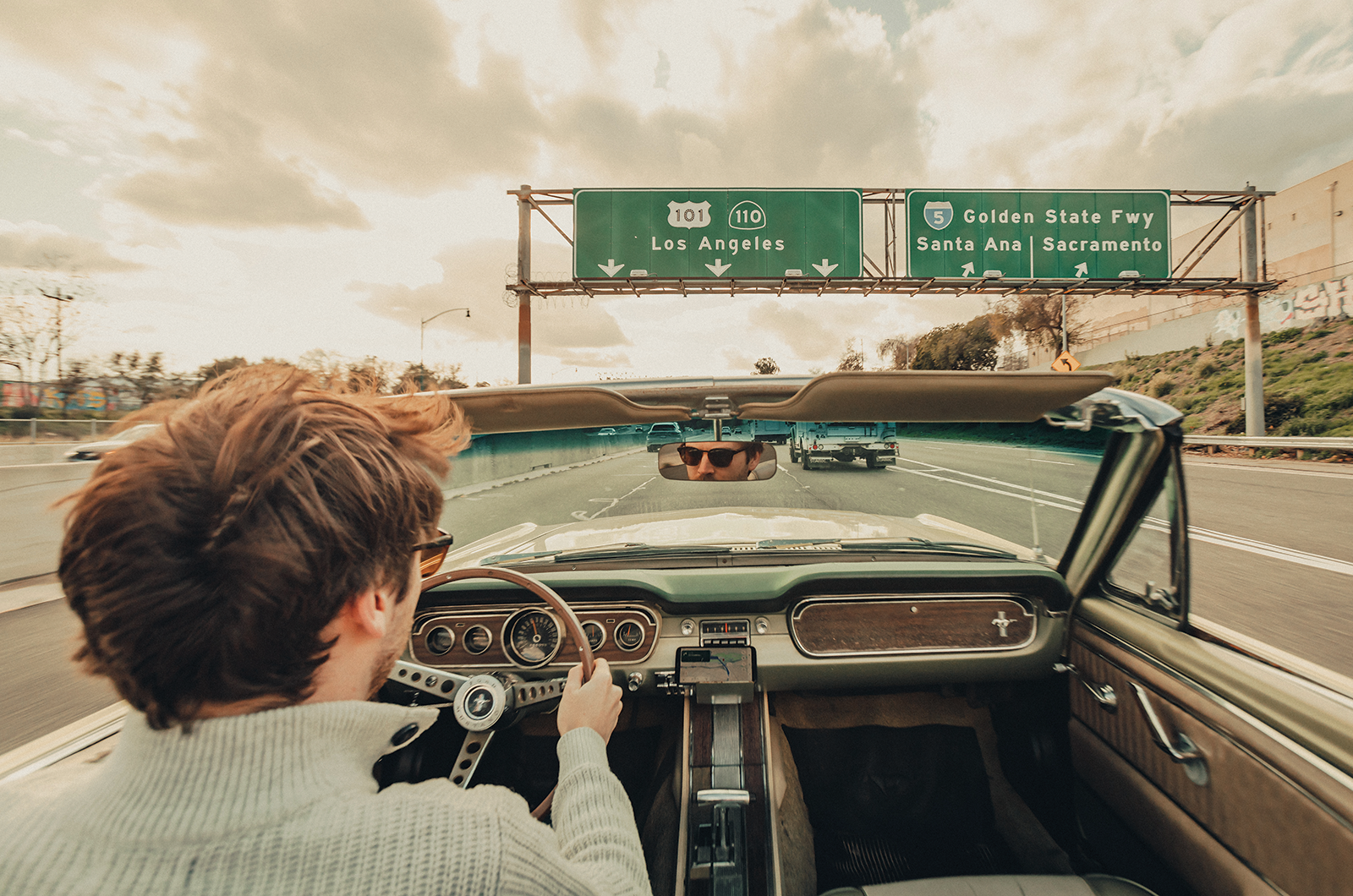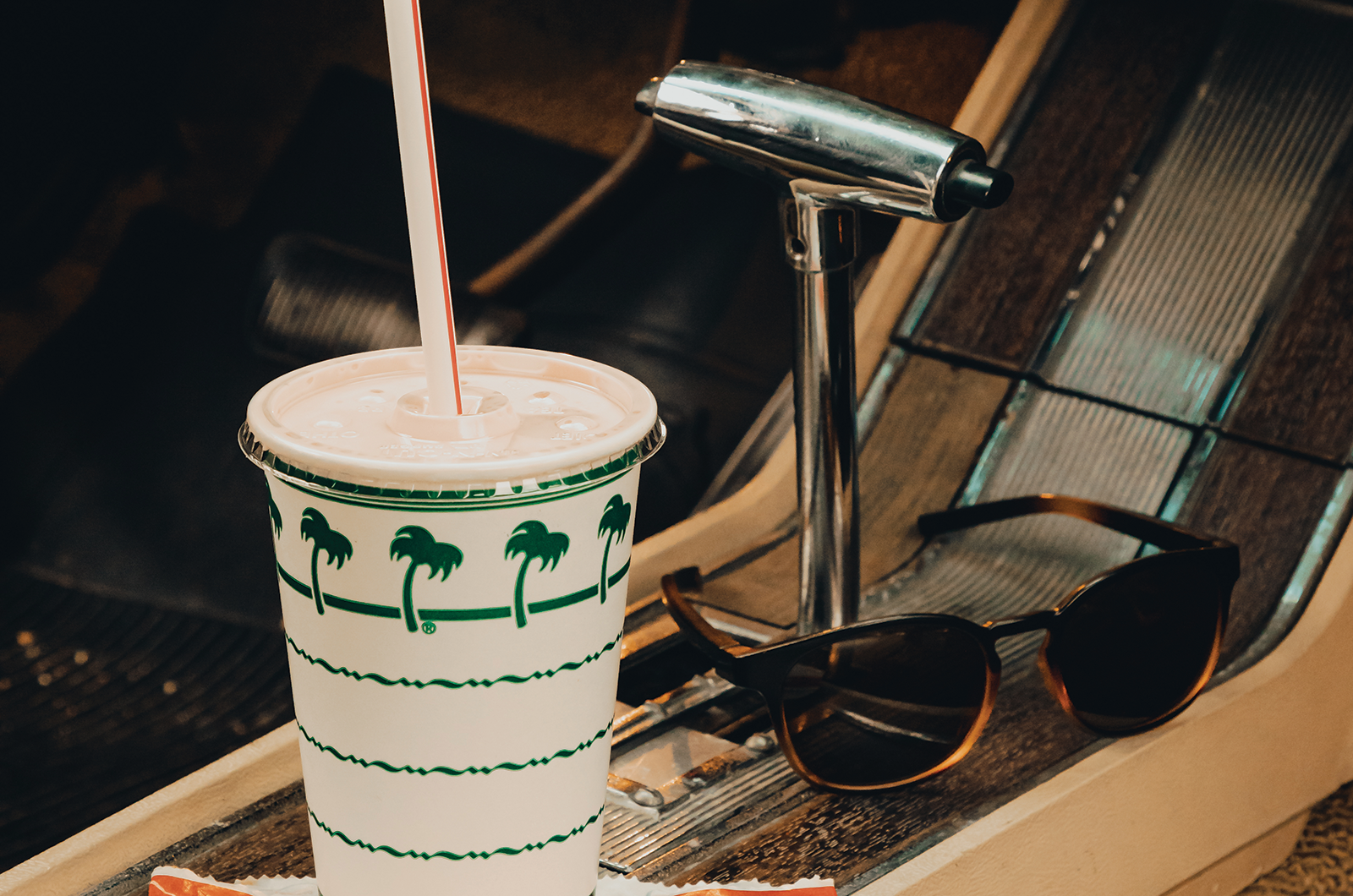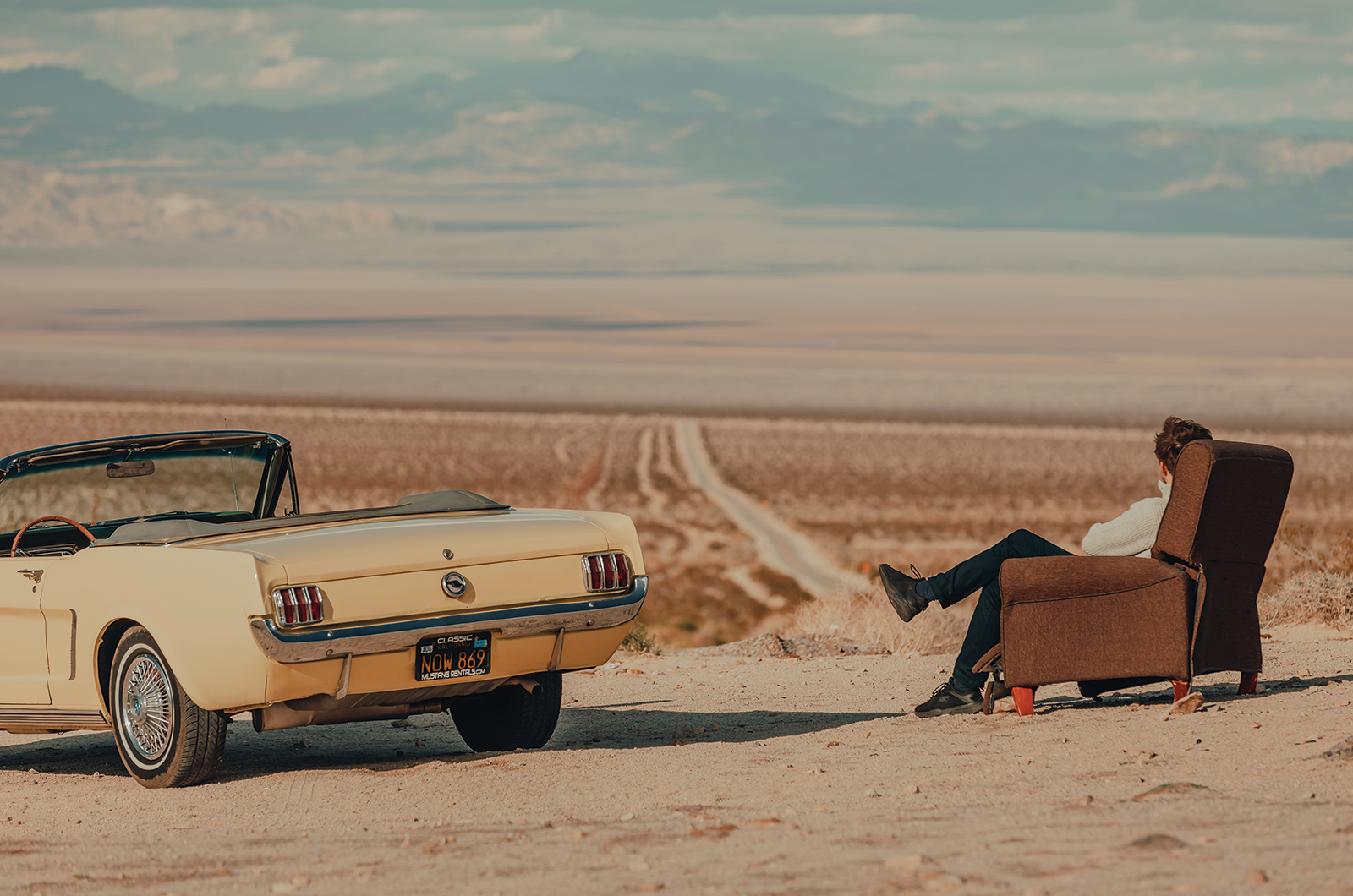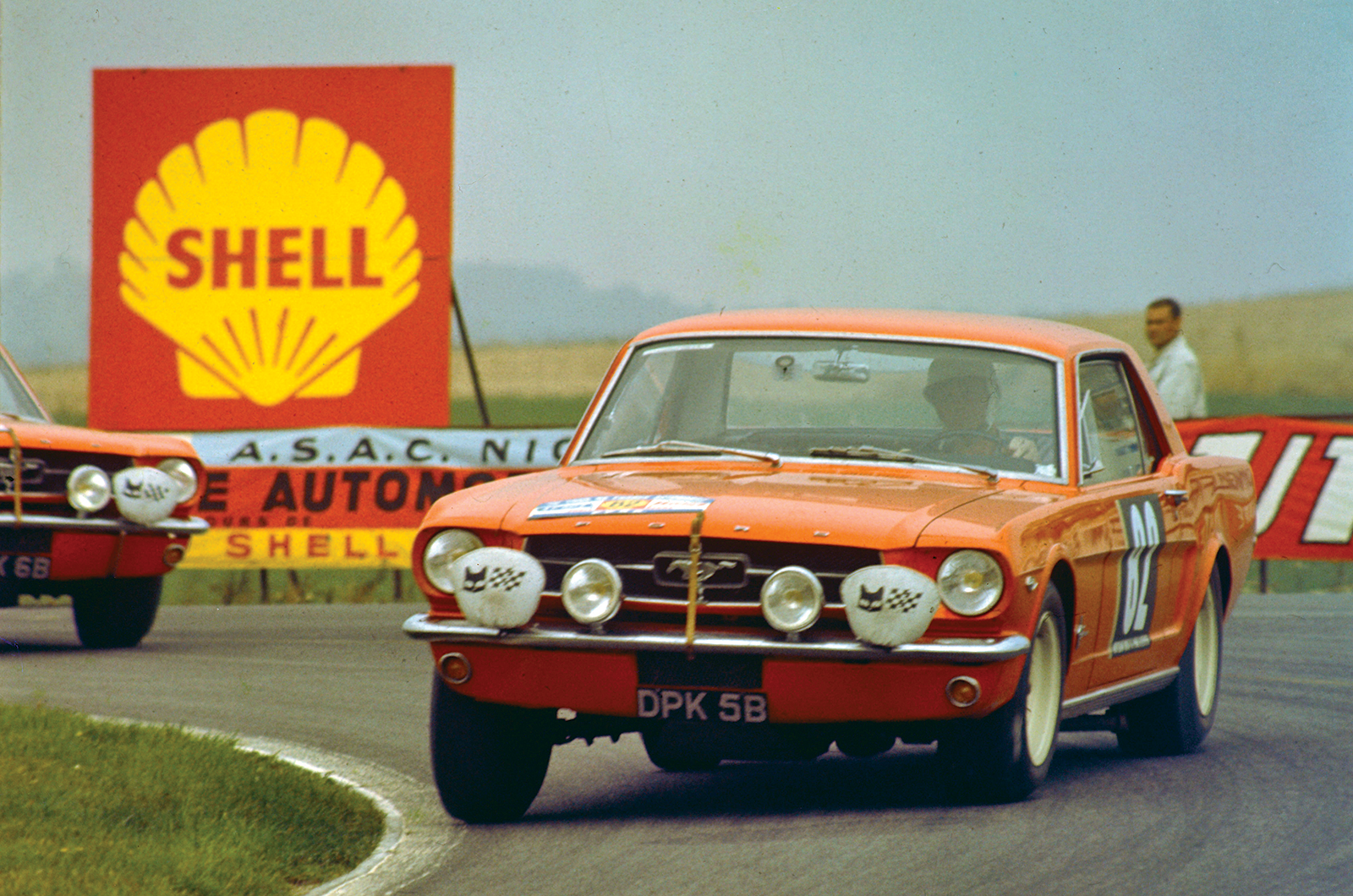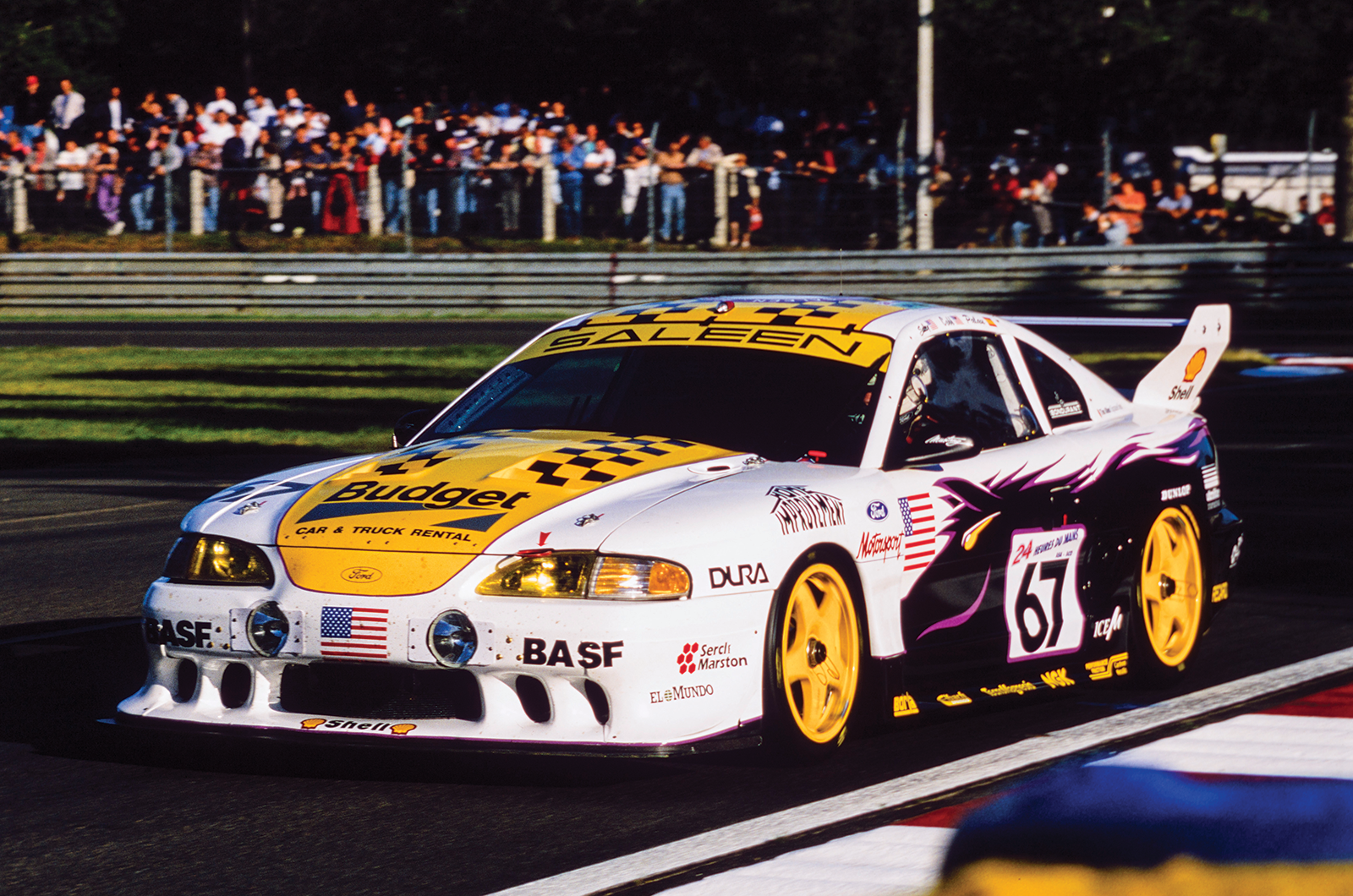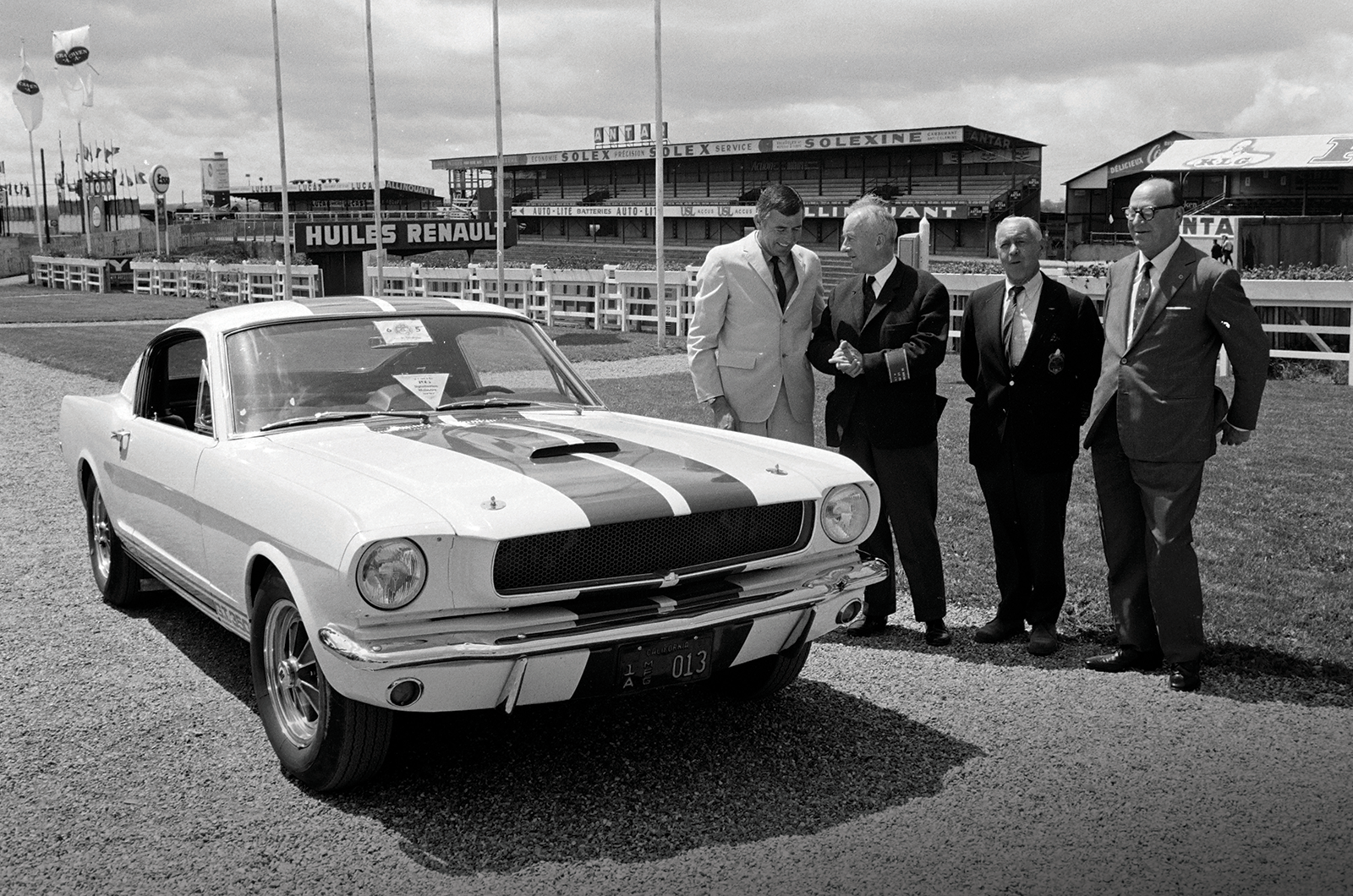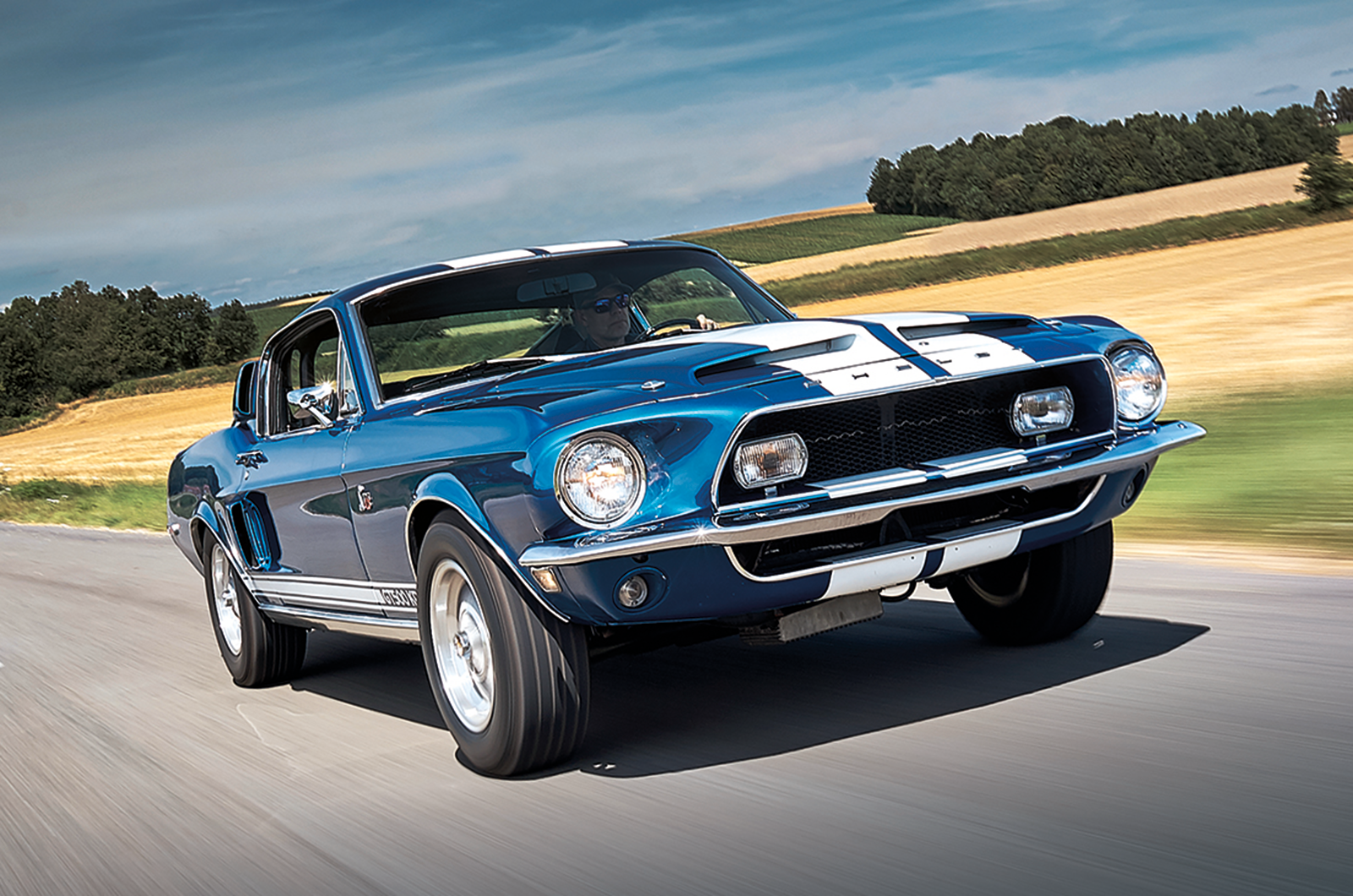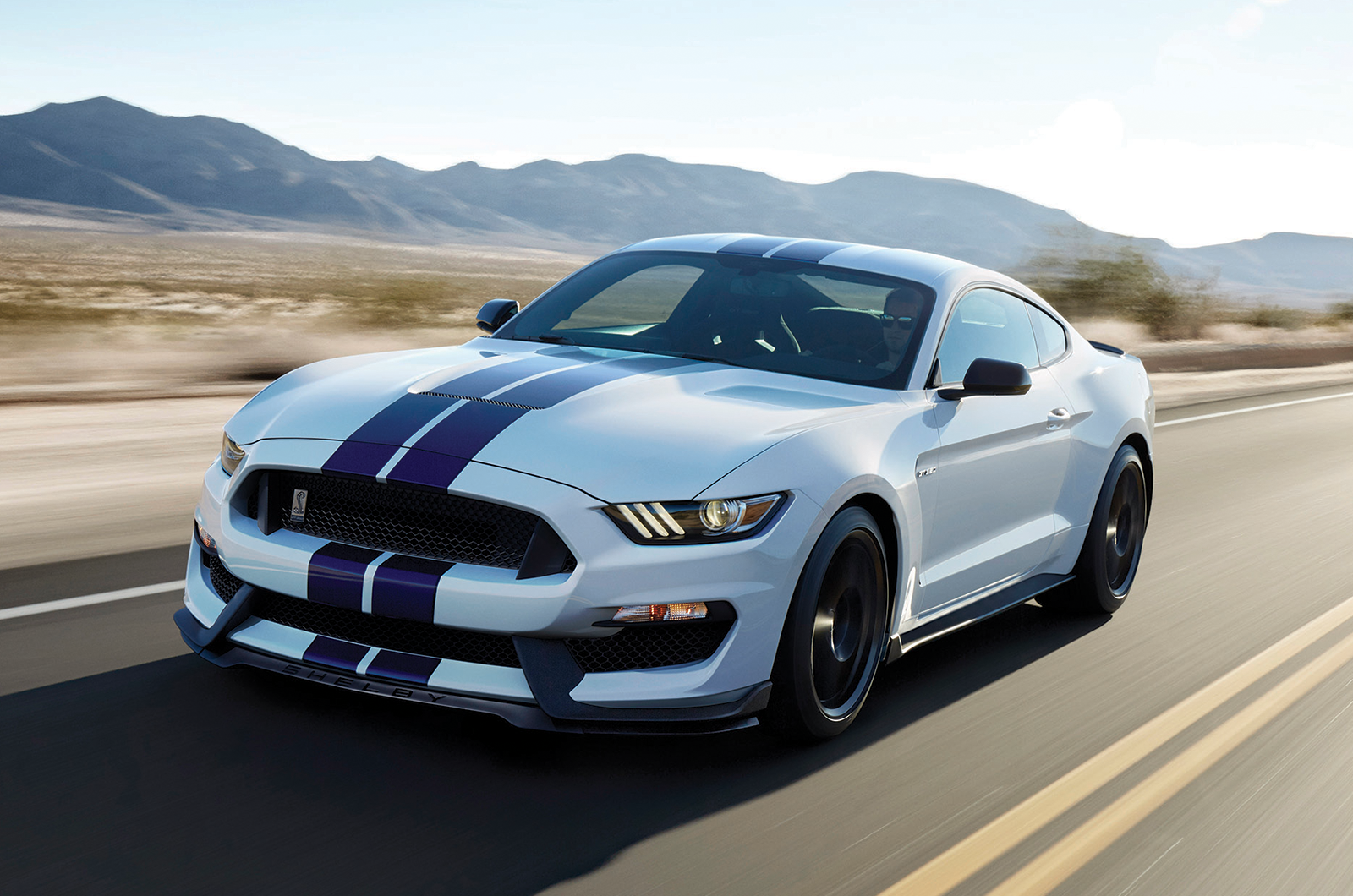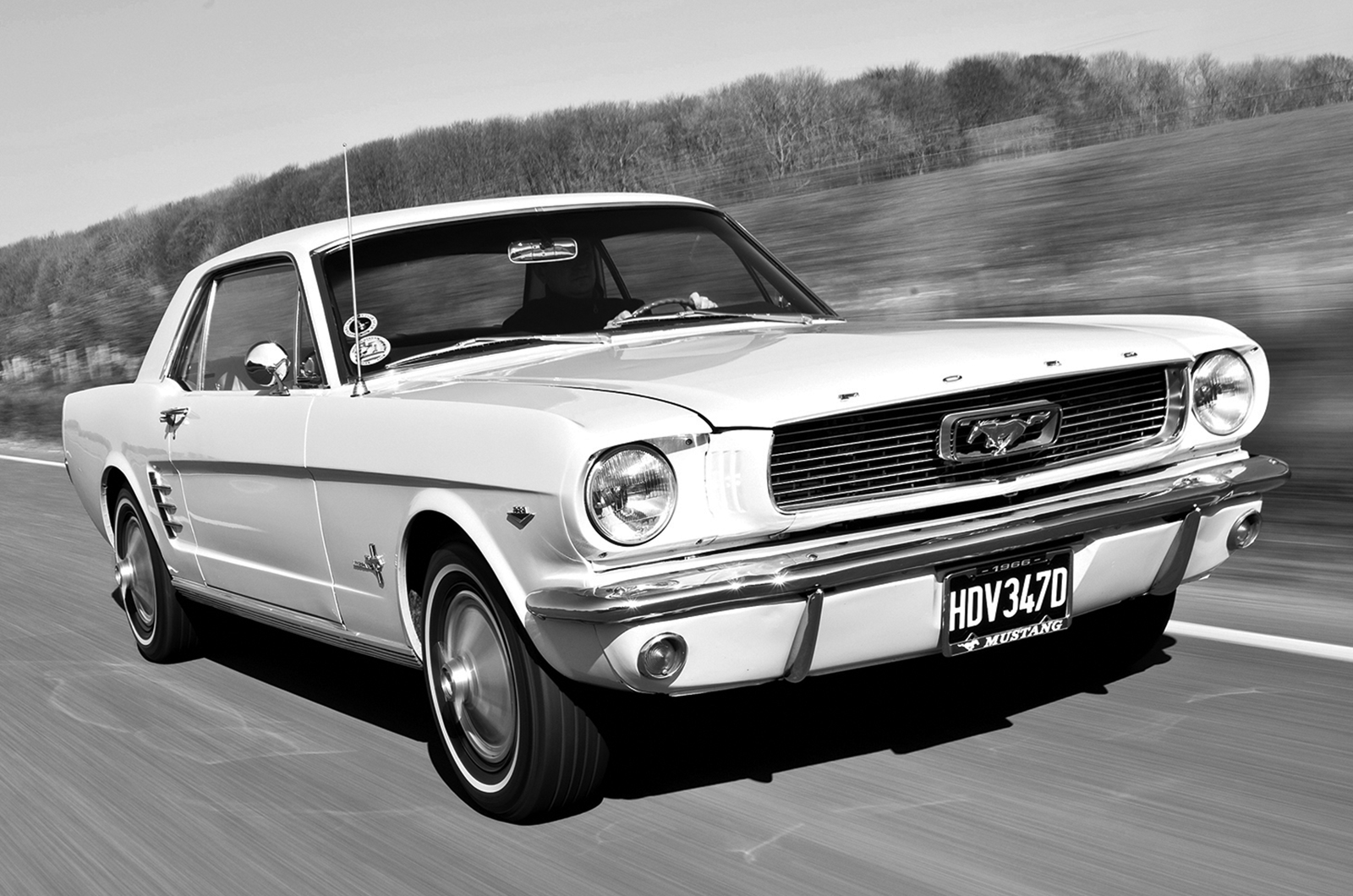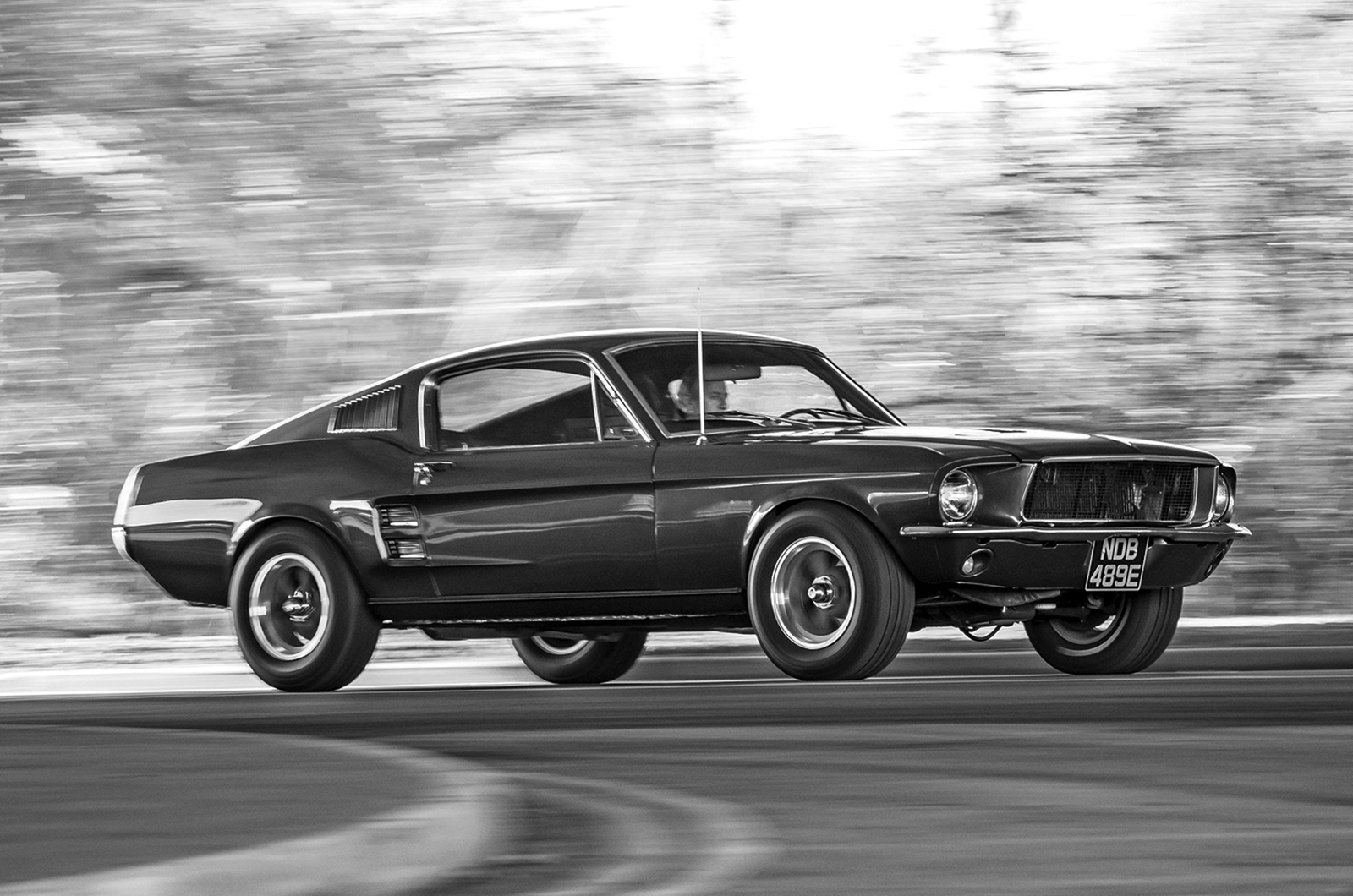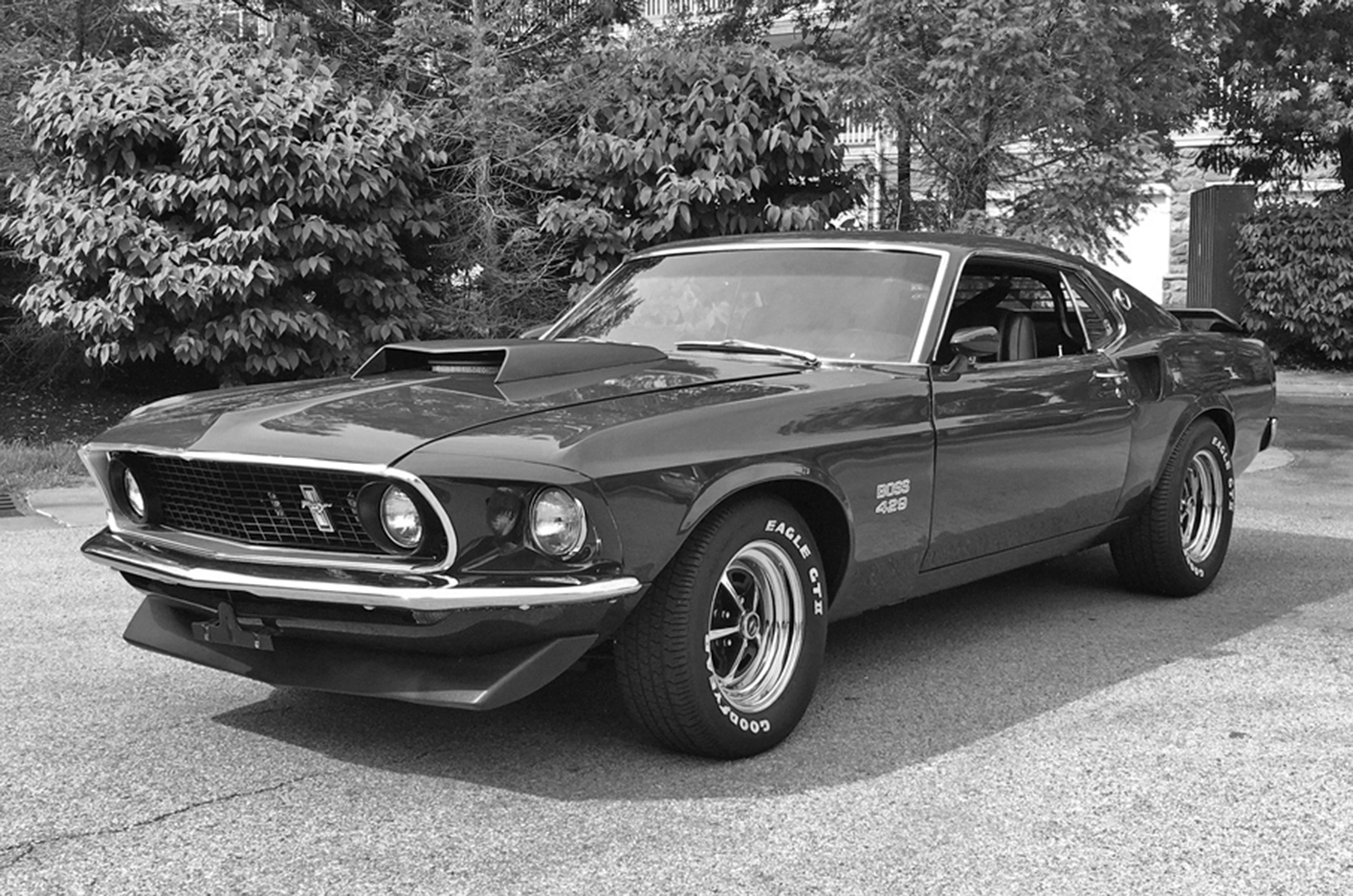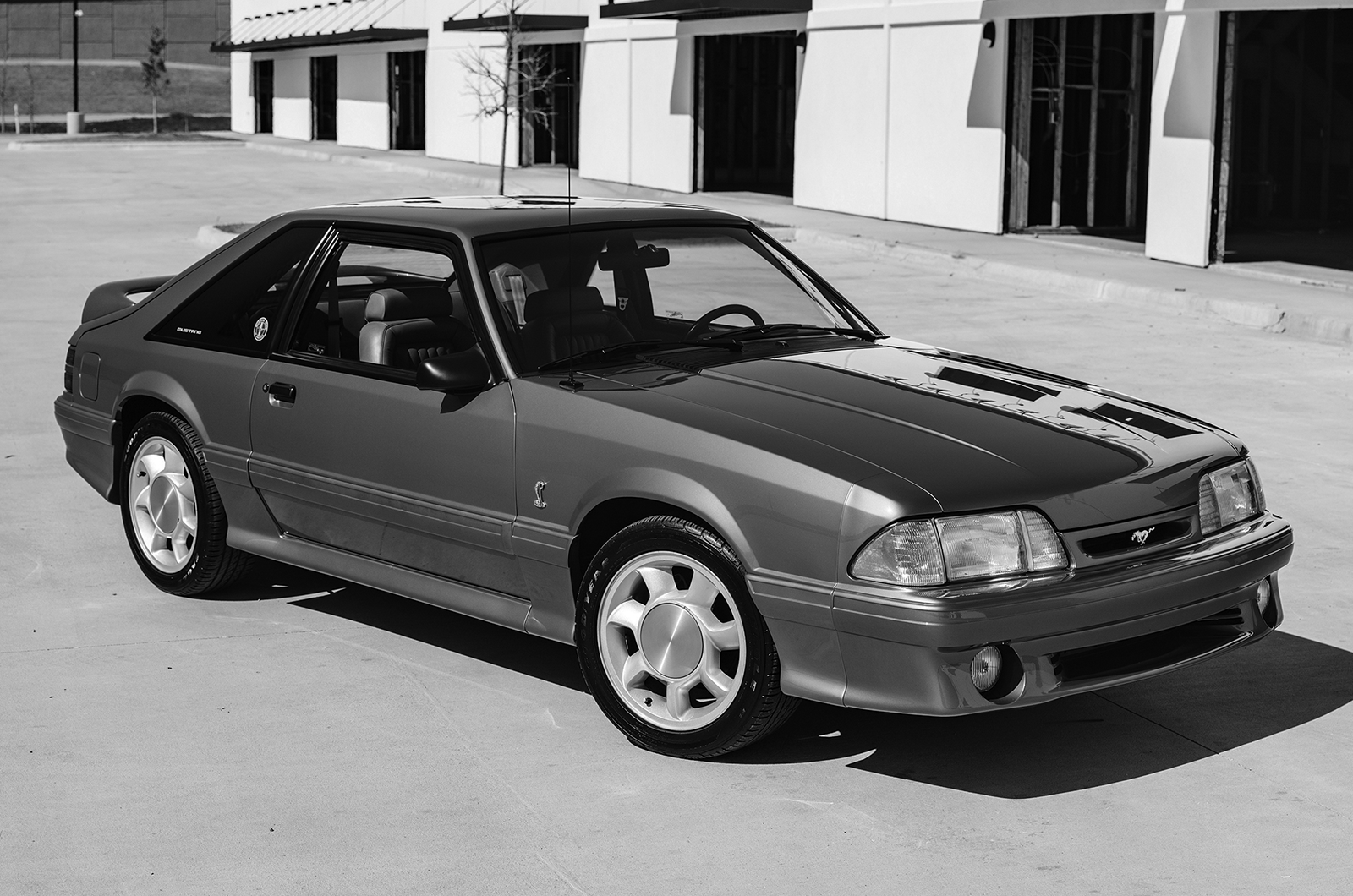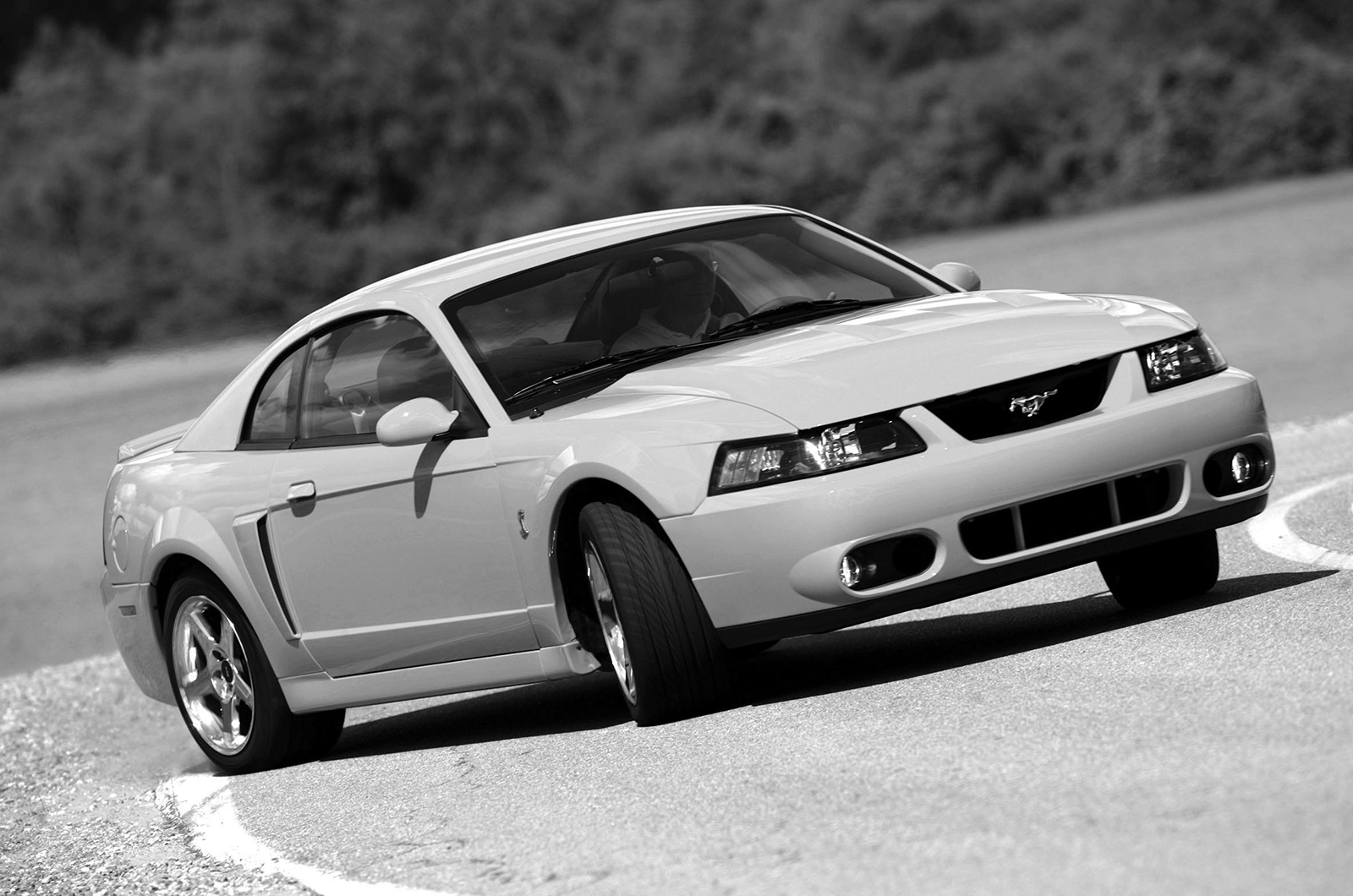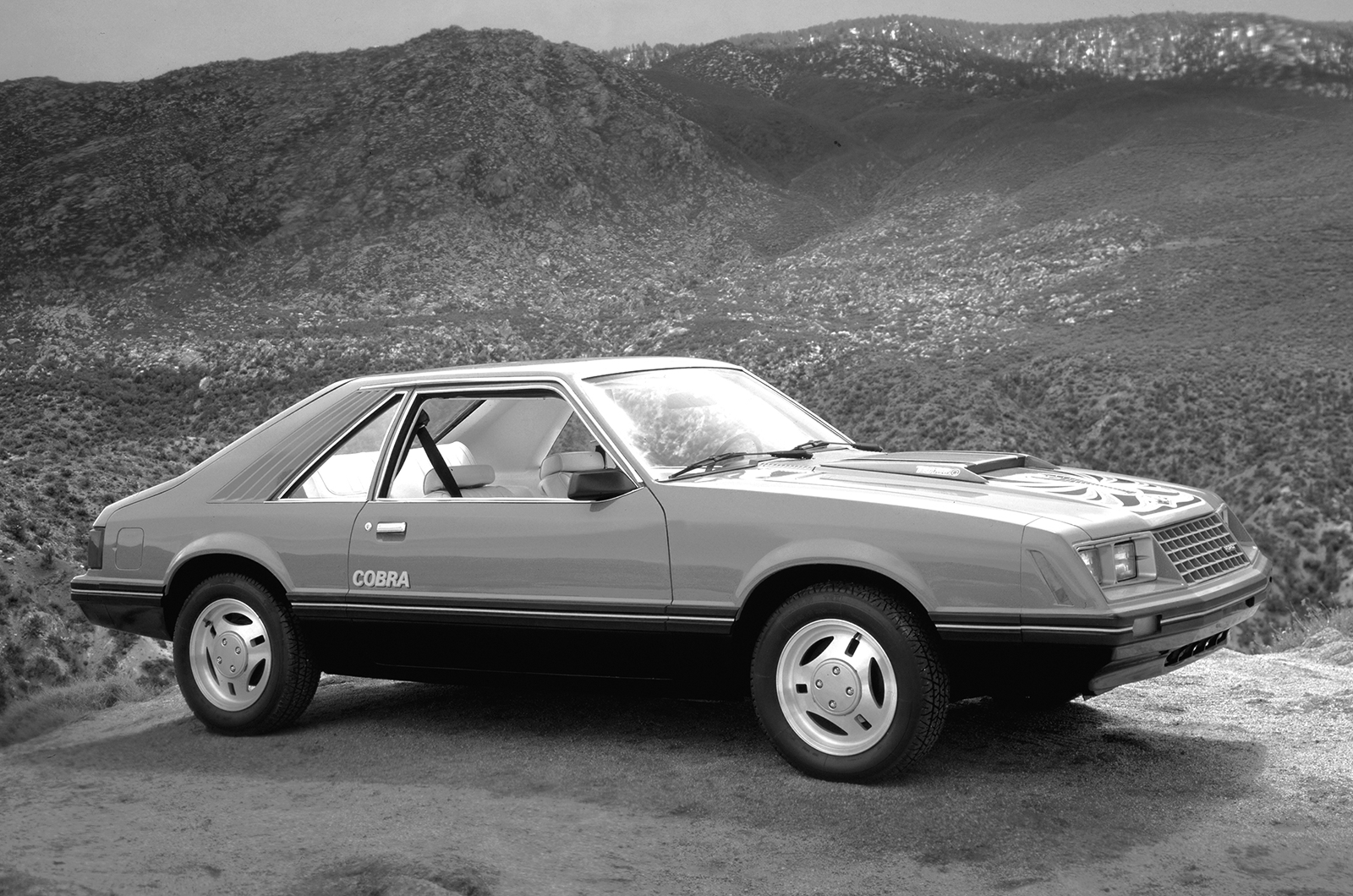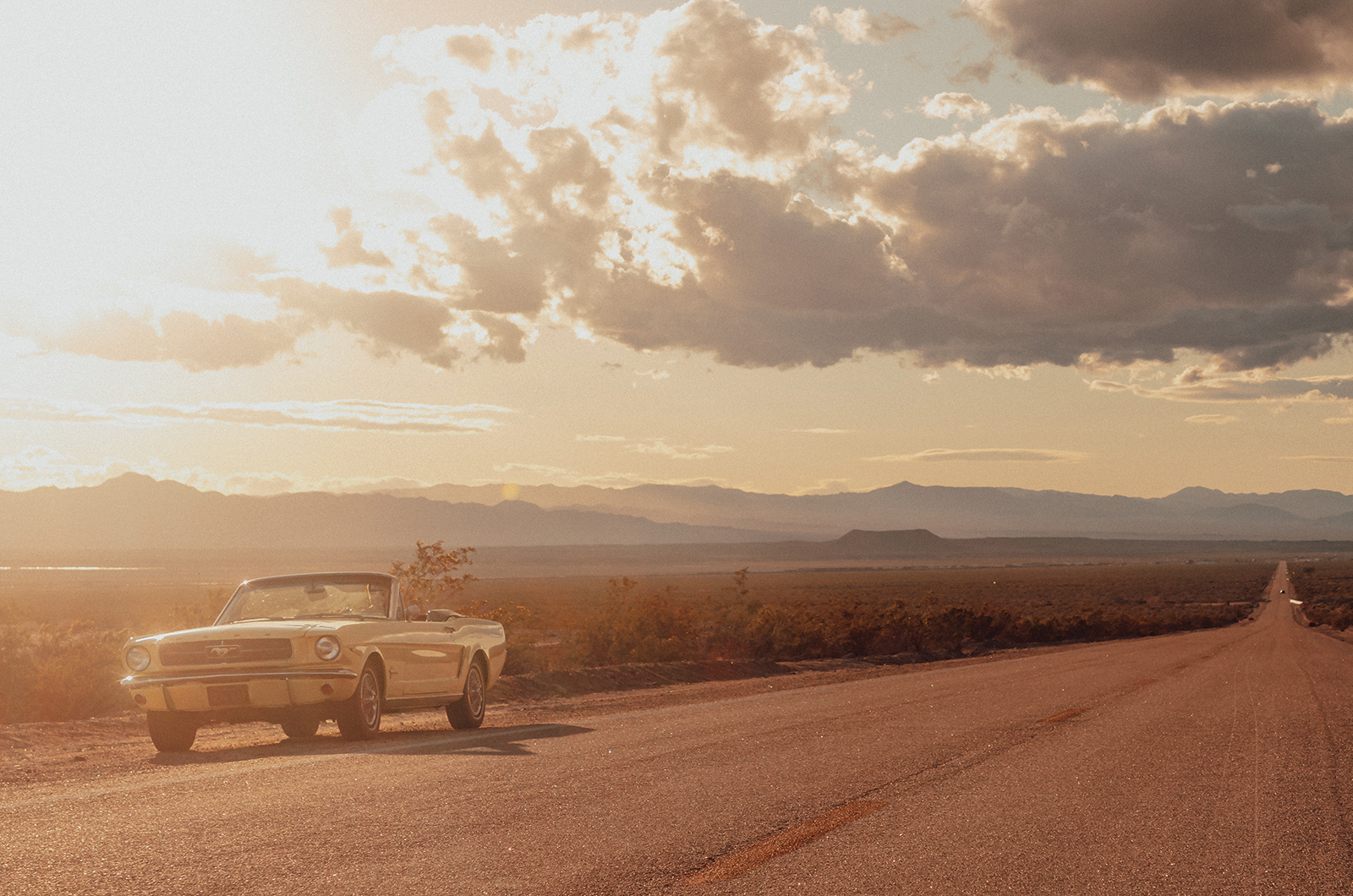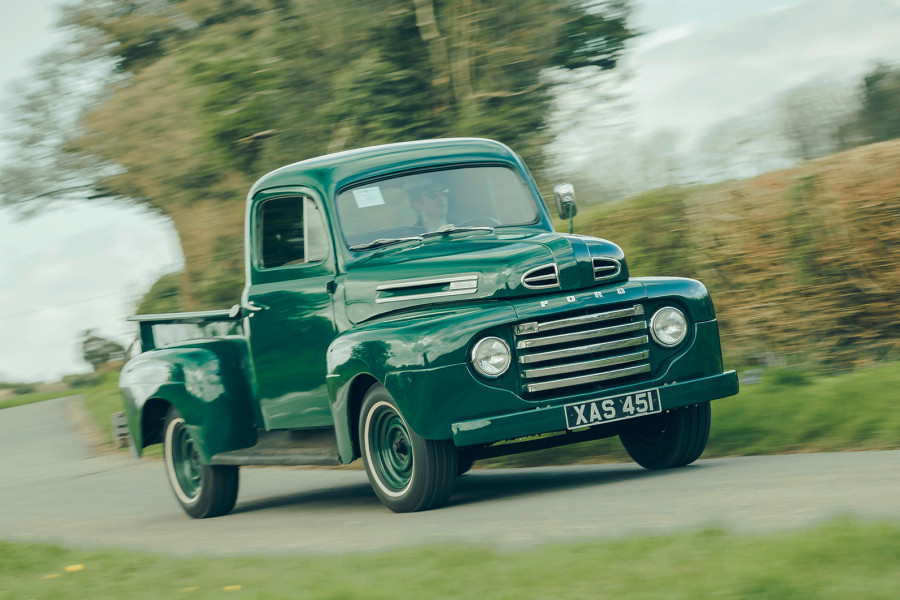From there until the mountains that separate greater LA from the rest of the state, I15 has been built right over the top of the old route.
Head on to a busy freeway in the Ford Mustang and you’re reacquainted with the wandering steering that wasn’t an issue on slower roads.
This far from LA the highway is modest by American standards, at four lanes per side, but those lanes are narrow and the Mustang is dwarfed by all but the odd hatchback.
The steering needs constant corrections to keep us straight, even if over-the-shoulder checks are a breeze.
With the roof down you can look back straight over the boot, thanks to the car’s low waistline and lack of head restraints.
On the road to Calico, a former mining town which was restored in the 1950s
This exposure reminds you of the Mustang’s age. That and the buffeting from the wind and the sawing at the wheel.
But, in fairness to the Ford, one thing it can do is speed.
What would have excited the buyer of this 289 in 1965 is that you’ve got what we would today call modern cruising ability.
You’re not relegated to mixing it with the lorries, like you would be in many mainstream classic cars, and the Mustang feels quite comfortable at 70mph.
Top gear is relaxed and the suspension is soft enough to be supple.
The Ford Mustang takes a break outside a Route 66 motel
Terrifying though it is threading the Ford between the pantechnicons, doing so bounces back the sound of the V8 to create a delicious, deep drumroll, and you soon come to revel in the experience.
Once again, the Mustang has a way of turning frowns into smiles.
Route 66 reappears halfway through the Cajon Pass and swings south-east into San Bernardino before a sharp turn west towards LA.
Still short for time, we’re forced to cut the corner here, staying on I15 to pick up Route 66 at Rancho Cucamonga.
There’s time for a quick lunch and Angelenos are fanatical about the In-N-Out Burger chain, so it seems rude not to try it.
‘The distant thrum of the Mustang’s V8 gives an addictive impression of speed. The sensation is that you’re going faster than you really are, making you feel like the hero of your own movie’
The queue for the drive-thru stretches up the road, so we do the un-American thing of parking and walking into the restaurant.
It’s leaving In-N-Out that proves a struggle.
‘Our’ Ford Mustang has suffered from an annoying tendency to cut out at junctions, and it is becoming more noticeable: it will roll up to a stop sign with little or no throttle, sit happily at idle, then choke as you put your foot down.
In a succession of low-speed turns after lunch, we conk out in the middle of each crossroad, putting it into neutral and restarting before creeping away with as little throttle as possible.
The European caricature of American drivers is that they are quick to enrage, but I’m not beeped or sworn at: the Mustang effect again.
The railway still goes through Amboy, but a four-lane interstate has since diverted Route 66 traffic away from the town
The stretch across the northern edge of LA’s huge sprawl isn’t exactly charismatic, but the nickname ‘America’s Main Street’ proves true here, going straight down what us Brits would call a high street into Old Pasadena.
It’s a fancy part of Southern California, particularly pretty where it dips down to the banks of the Arroyo Seco river, where it’s cooler and greener.
Above it all loom two great bridges spanning the valley.
The older Colorado Street Bridge is an infamous suicide spot, particularly so during the Great Depression.
Now it’s lined by three-metre-high chain-link fencing.
The Ford Mustang looks at home
The irony of this rich area building fences to stop the desperate dropping on to its lawns, rather than tackling the homelessness and deprivation that’s shockingly prevalent in LA, seems lost.
Route 66 changed direction in 1940, however, turning south just before the valley, so that is the route we take to Elysian Park.
An entire mountain in the middle of the city, with a small road system winding its way up, the park is astonishingly quiet on what we would consider a pleasant afternoon.
From here, it’s straight on to two of the most famous roads in the USA: Sunset Boulevard and Santa Monica Boulevard.
The Colorado Street Bridge has a tragic backstory
Route 66 officially ends two blocks north of Santa Monica Pier, but it’s the jetty that has nonetheless become the famous end point, and as we approach I have no idea if it’s going to be possible to get the Mustang on to it or not.
Vehicular access varies, so it isn’t until we get to the intersection in front of it that we see it’s open.
Max jumps out, Dukes of Hazzard-style, and he has until I turn around and come back to get in position for a photo of the car driving off the pier – and there’s nowhere for me to slow down or pull over after that.
Anyone who has been to an American city knows that crossing the road takes a long time.
The car is king and jaywalking is a punishable offence.
The Ford Mustang on the highway (left); In-N-Out is a local staple
The lights themselves take a long time to turn, and if you need to get to the opposite side of a crossroad with two crossings, you’ll be waiting minutes.
As I sit in the queue to get off the pier at a red light, I can see Max still stuck trying to do his second crossing.
His light changes just before mine, and he runs into position for our big finish-line shot.
After that, we just have the small matter of getting from one side of LA to the other in the evening rush-hour.
We manage to avoid some of the traffic by snaking through the million-dollar neighbourhoods of Ocean Park and Venice, but it is only delaying the inevitable: for the next two hours we crawl along the 405.
The end of the road: Route 66 stops just short of Santa Monica’s famed pier, but the beachfront attraction still serves as a fitting full stop to this epic Ford Mustang adventure
Our journey has made it clear just how broad the Ford Mustang’s ability is, but it had to be in order to have sold so well and enjoyed such enduring success.
It’s a capable GT with sporting appeal, but also a reasonably economical commuter in straight-six form; or with more powerful engines it becomes a storming muscle car.
All while seating four in comfort and costing about the same as a typical family car.
The term ‘pony car’ was created for it, but for me that only describes the six-cylinder models and ignores all those other hats the famous Ford has worn.
‘The scale of the emptiness is unfathomable – 30 miles of nothing in each direction’
The magic of the Ford Mustang is how it ticks the ‘ordinary car’ boxes – affordability, reliability, practicality – yet makes you feel just as special as that millionaire in a Ferrari.
Which makes it an exceptional long-distance companion.
There have been challenging moments, but the Mustang soldiers on and always put smiles on our faces.
An epic road trip is never what you first imagine it will be – things do go wrong and adventures happen – but a brilliant car such as this makes it a dream nonetheless.
Images: Max Edleston
Thanks to: Ford Motor Company and Sunland Ford
Ford Mustangs on track
The Ford Mustang triumphed in the 1965 British Saloon Car Championship © Ford
Ford wasted no time in getting the new Mustang into competition, with three Alan Mann Racing cars giving the model its race debut on the ’64 Tour de France, securing a 1-2 in the Touring class.
Roy Pierpoint (above) won the 1965 British Saloon Car Championship with an AMR car, too.
Back in the USA, Ford called on Holman-Moody to build the A/FX racer (below) for the 1965 drag-racing circuit, while Shelby prepared 36 GT350Rs, one of which won the Mustang’s first Sports Car Club of America race in the hands of Ken Miles on 14 February of the same year.
Drag racing was another big hit for the Ford Mustang © Getty
It went on to land the 1965 B/Production title, with further SCCA series wins in ’66 and ’67.
Ford joined Chrysler as one of the early supporters of the new Trans-Am series in 1966, winning the first two seasons with the Mustang.
Penske Camaros became the model’s arch rival as works teams piled into Trans-Am, but the Ford came back to win again in 1970 before factory support was pulled.
The Mustang remained ever present in privateer hands, however, including a trophy-laden period in the late ’80s and early ’90s for Roush Racing.
Saleen took the Ford Mustang to Le Mans in the 1990s © Motorsport Images
The GT40 and later GT have always stolen Ford’s headlines at Le Mans, but Claude Dubois took a Shelby GT350 to the Circuit de la Sarthe in 1967, while Saleen followed its SCCA successes with Le Mans showings in the late ’90s (above).
After 60 years, however, Ford returned a factory-backed Mustang to the 24 Hours in 2024, having unveiled the new Mustang GT3 at last year’s race.
All three entrants finished, the highest claiming a podium with a third-in-class result.
Shelby: the Texas connection
The Carroll Shelby-developed 1965 Ford Mustang GT350 was lighter, handled better and produced 306bhp © Motorsport Images
Already embedded in the Ford Motor Company via his Ford-powered Cobras and work on the GT40 race car, Texan Carroll Shelby was the natural port of call in 1965 when the Blue Oval wanted to produce a hotter variant of the Mustang to compete against Chevrolet’s Corvette in Sports Car Club of America racing.
Shelby moved from his workshop in Venice, LA, to a hangar at nearby LAX airport to produce the new GT350.
It had 306bhp and less weight, while handling was improved via extra bracing, a thicker front anti-roll bar, adjustable Koni dampers and reworked geometry.
Ford sold 1002 Mustang GT350s to car rental company Hertz
A more refined GT350 arrived in 1966, including 1002 sold to rental company Hertz, mostly in black and gold (above), although some were standard colours.
The entire Mustang range was restyled for 1967 when the 428cu in GT500 joined the line-up alongside the GT350, but as Shelby’s lease at LAX came up and he became increasingly disillusioned with the model for its weight and refinement, Ford took production back to Michigan in 1968.
The Shelby GT350 and GT500 (later GT500 KR, below) survived two more years as the Mustang was rebodied once again, but the models became less popular as other variants in the Mustang range overtook them.
The Ford Mustang GT500 KR lived up to its ‘King of the Road’ moniker
The agreement with Shelby ended, but not before Ford had bought the Cobra name for itself.
With the retro-styled fifth-generation model in the works, Ford revived the Shelby deal 33 years later, and the first new Shelbys to break cover were 500 cars sold to Hertz in 2006, as the GT-H.
These would form the basis for the 2007 Shelby GT, essentially a sporty top trim in the Mustang range.
The real revival was the GT500 released in the same year, a supercharged 500bhp monster that topped the line-up and offered supercar power at a bargain price.
Modern-day Shelby Mustangs are tweaked for race tracks © Ford
Finally, the sixth-generation Mustang, with its much-improved handling, was the starting point for a new Shelby GT350 in 2015 (above).
With it, Ford created a Mustang that could once again match the Corvette around a race circuit.
A new GT500 replaced that in 2020, bringing supercharging back into the mix for its two-year run before the sixth-generation model bowed out.
With a new Mustang just released, no Shelby variant has yet been announced, but you would be foolish to bet against it.
Ford Mustang: greatest hits
Clockwise from top left: Ford Mustang 289; Ford Mustang Fastback GT; Ford Mustang California Special; Ford Mustang Boss 429
1. 1964½-’66 Ford Mustang 289
The first Mustang took less than two years to reach one million cars built – setting yet another record.
The performance option in those early years was the 289cu in V8, available with outputs from 200bhp to the 270bhp Hi-Po, the latter among the most desirable Mustangs ever made.
2. 1967-’68 Ford Mustang Fastback GT
The rakish body shape and GT package date back to 1965, but the ’67 restyle created what many feel was the best-looking Mustang.
The 1967/’68 fastback in V8-only GT form has now become the stock answer to the question of the best standard first-gen Mustang – and prices reflect that.
3. 1969 Ford Mustang California Special
The Golden State bought more Mustangs than any other in the 1960s.
Local dealers pushed for a special edition, and put a host of Shelby exterior parts on to a standard notchback body.
Offered with all engine options in the line-up, 4325 were built and they are highly collectible today.
4. 1969-’70 Ford Mustang Boss 429
The ’69 Mustang was bigger and badder-looking as the Big Three engaged in a horsepower war on the street and the race track.
The Boss 429 homologated Ford’s new 375bhp, 7-litre semi-hemi-head big-block V8 for NASCAR racing – even though it raced Fairlanes, not Mustangs.
Clockwise from top: 1993 Ford Mustang SVT Cobra; Ford Mustang SVT Cobra ‘Terminator’; Ford Mustang Bullitt
5. 1993 Ford Mustang SVT Cobra
Ford’s Special Vehicles Team (SVT) was tasked with hotting-up the third-gen ‘Fox body’, creating the SVT Cobra.
Conservatively rated at 235bhp, it was a regular showroom model that could take a dragstrip as quickly as a late-’60s beast.
‘R’ package made the best-handling Mustang yet.
6. 2003-’04 Ford Mustang SVT Cobra ‘Terminator’
SVT’s 10th-anniversary effort supercharged the fourth-generation SVT Cobra’s 4.6-litre V8 to create the internally tagged ‘Terminator’.
With 390bhp plus an SVT Cobra-only independent rear end, it offered performance unlike anything else at its price.
7. 2008 Ford Mustang Bullitt
Harking back to the 1968 movie-star fastback, this retro-styled 2008 fifth-generation S197 Mustang received various mechanical upgrades including a bump in power and cinema-buff details such as a front-badge delete.
The model returned in 2018/’19, and we expect it again in 2028.
Ford Mustang: greatest misses
Clockwise from top: Ford Mustang II 2.3; Ford Mustang Cobra; Ford Mustang 4.2 V8
1. 1974-’78 Ford Mustang II 2.3
It sold well following the the 1973 Fuel Crisis, but the first four-cylinder Mustang, a 2.3-litre that was the standard option when the Mustang II was introduced, was the dampest squib of all.
With just 88bhp, it gave 0-60mph in more than 13 secs and barely cracked 100mph. All for 26mpg.
2. 1979-’80 Ford Mustang Cobra
The ‘Fox body’ was the first Mustang to offer a turbo, with a basic blow-through, non-intercooled 2.3-litre ‘four’ in the 1979 Cobra.
But it gave an underwhelming 134bhp and was beset by reliability issues.
At least it inspired the far better ’84 SVO and a host of future forced-induction Mustangs.
3. 1980-’81 Ford Mustang 4.2 V8
The third-generation never suffered the Mustang II’s ignominy of being offered without a V8 for part of its life, but the two years of the 4.2 were still a nadir.
A response to the 1979 Fuel Crisis, it mustered just 119bhp.
A 5-litre returned in ’82, initially weak but with a healthier 225bhp by ’87.
Factfile
Ford Mustang 289
- Sold/number built 1964-’65/680,989
- Construction steel monocoque
- Engine all-iron, ohv 4727cc V8, single Autolite four-barrel carburettor
- Max power 210bhp @ 4400rpm
- Max torque 300lb ft @ 2400rpm
- Transmission three-speed automatic, RWD
- Suspension: front independent, by unequal-length wishbones, coil springs, anti-roll bar rear live axle, semi-elliptic leaf springs; telescopic dampers f/r
- Steering recirculating ball
- Brakes drums, with servo
- Length 15ft 2in (4597mm)
- Width 5ft 8in (1732mm)
- Height 4ft 3in (1295mm)
- Wheelbase 9ft (2743mm)
- Weight 2861lb (1297kg)
- Mpg 17
- 0-60mph 9.5 secs
- Top speed 110mph
- Price new $2662 (1965)
- Price now £35-80,000 (289 convertible)*
*Prices correct at date of original publication
Enjoy more of the world’s best classic car content every month when you subscribe to C&SC – get our latest deals here
READ MORE
60 years of the Ford Mustang
Muscle-car shoot-out: Chevrolet Camaro SS 396 Indy Pace Car vs Shelby GT500 Cobra Jet
Ford Mustang Boss 302 vs Mach 1: two-trick ponies
Charlie Calderwood
Charlie Calderwood is Classic & Sports Car’s Features Editor
